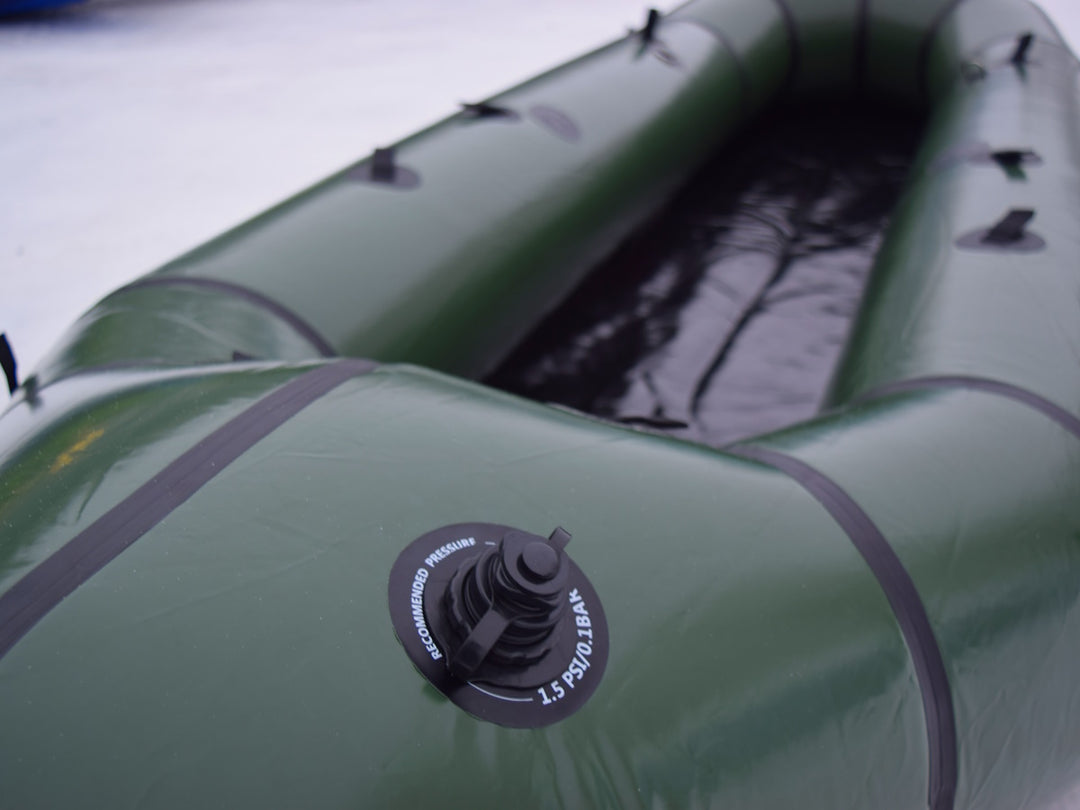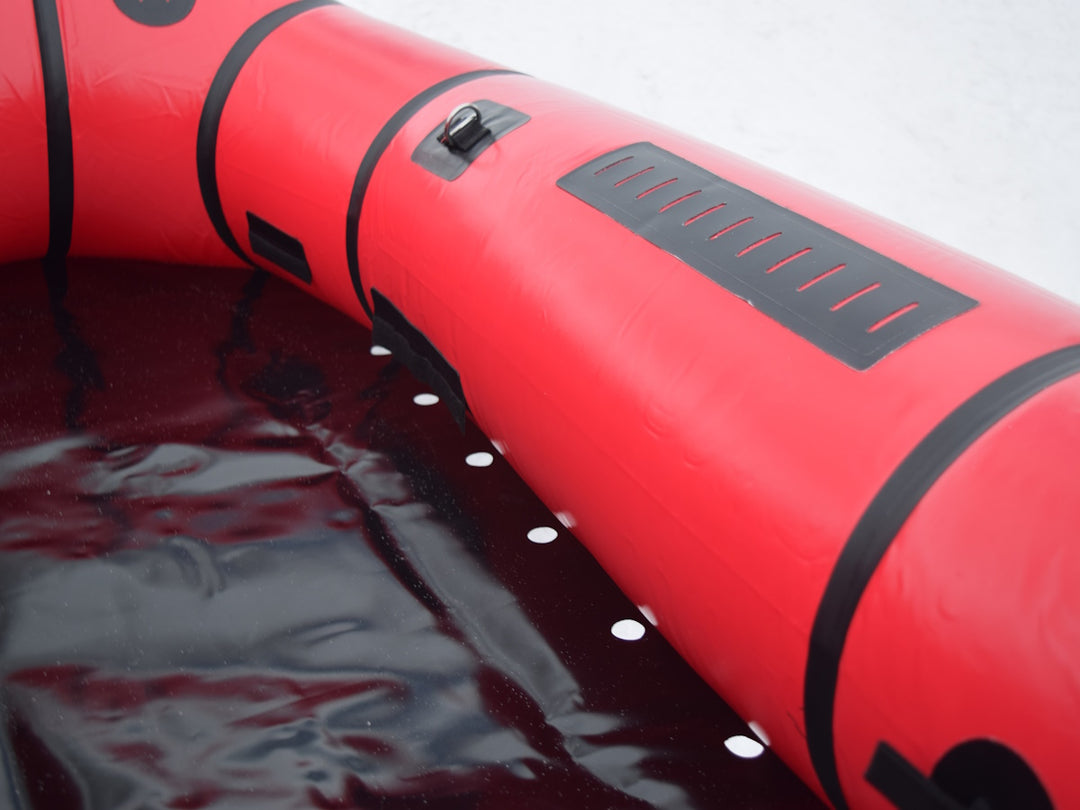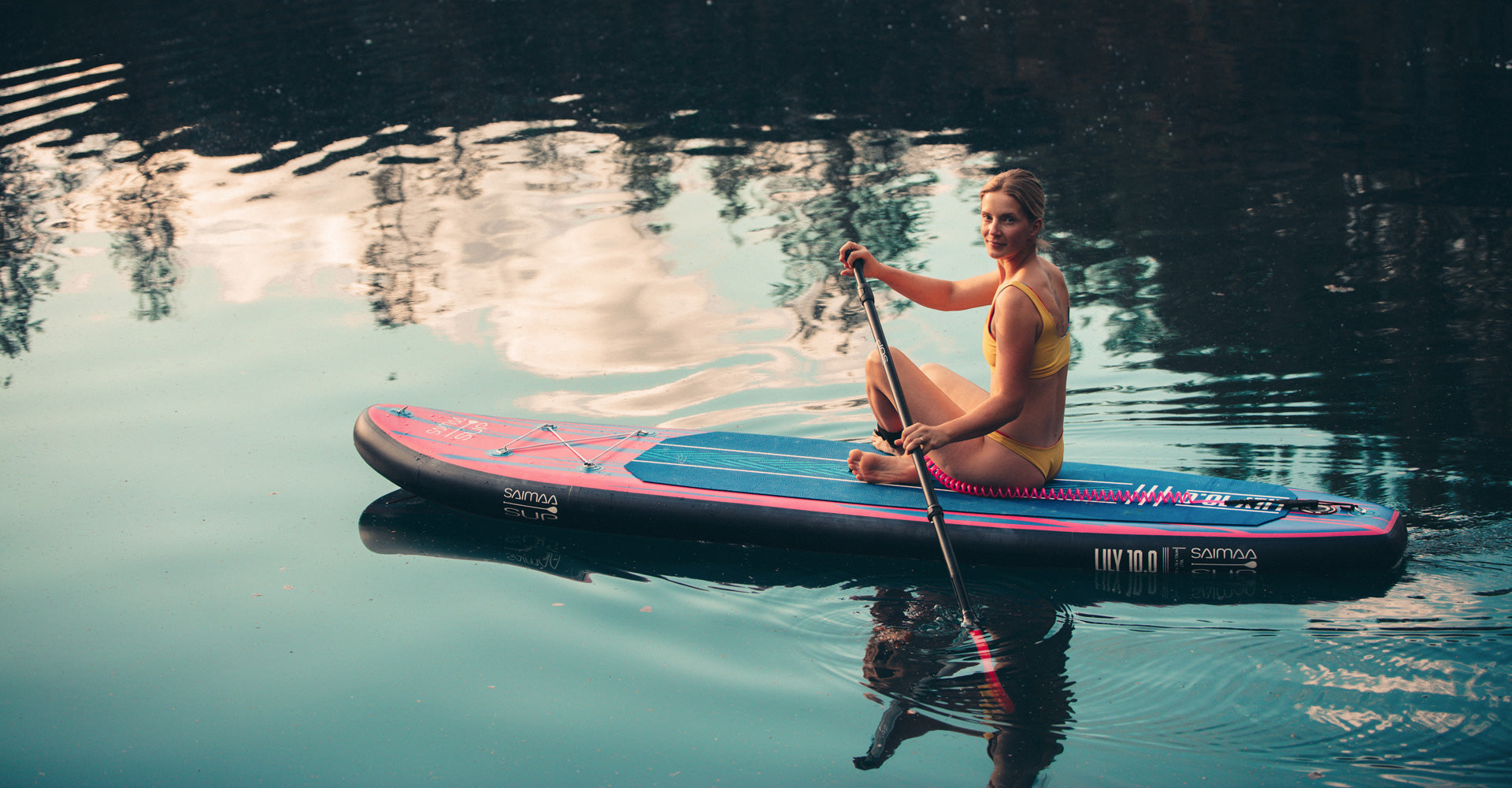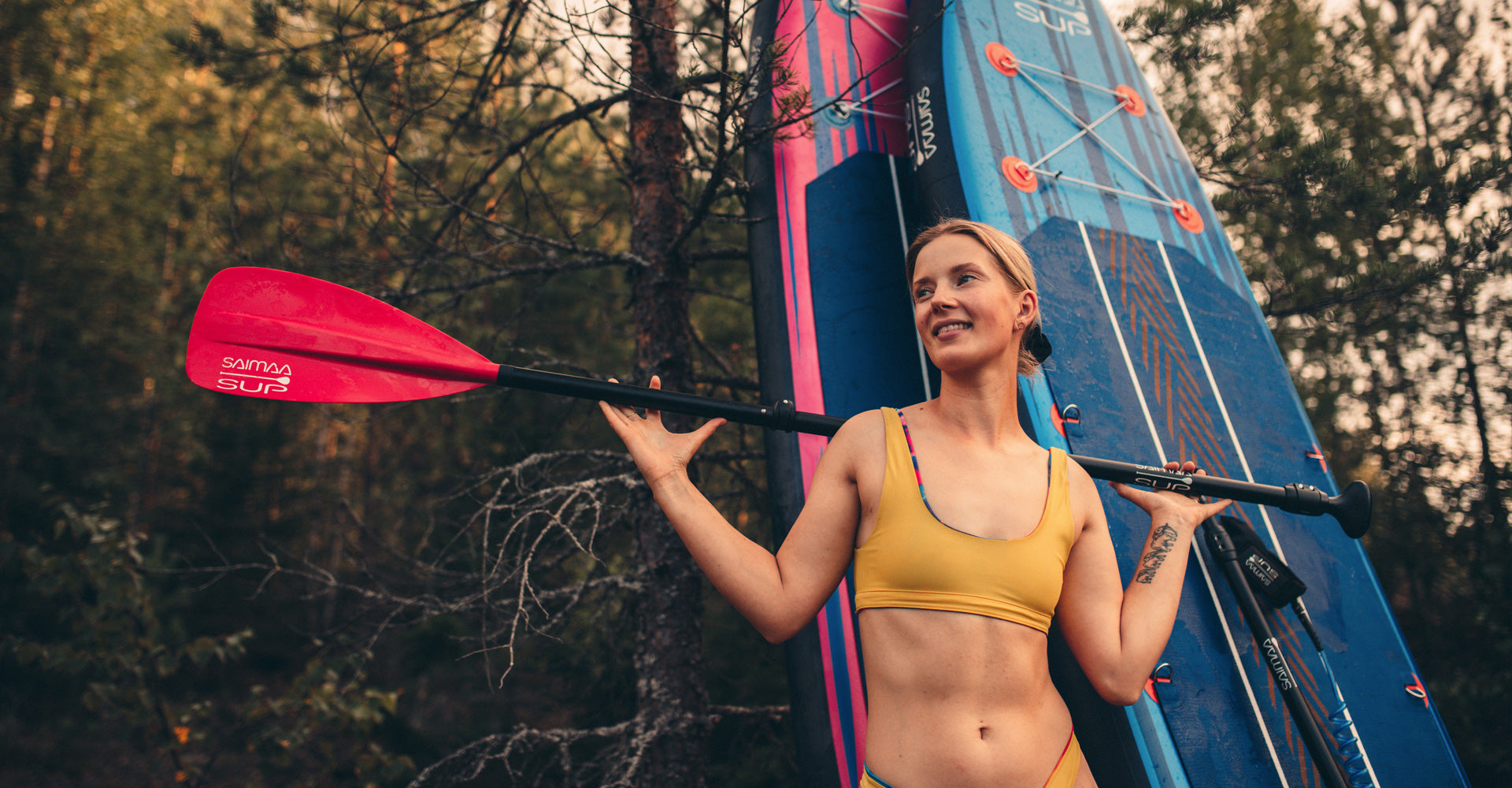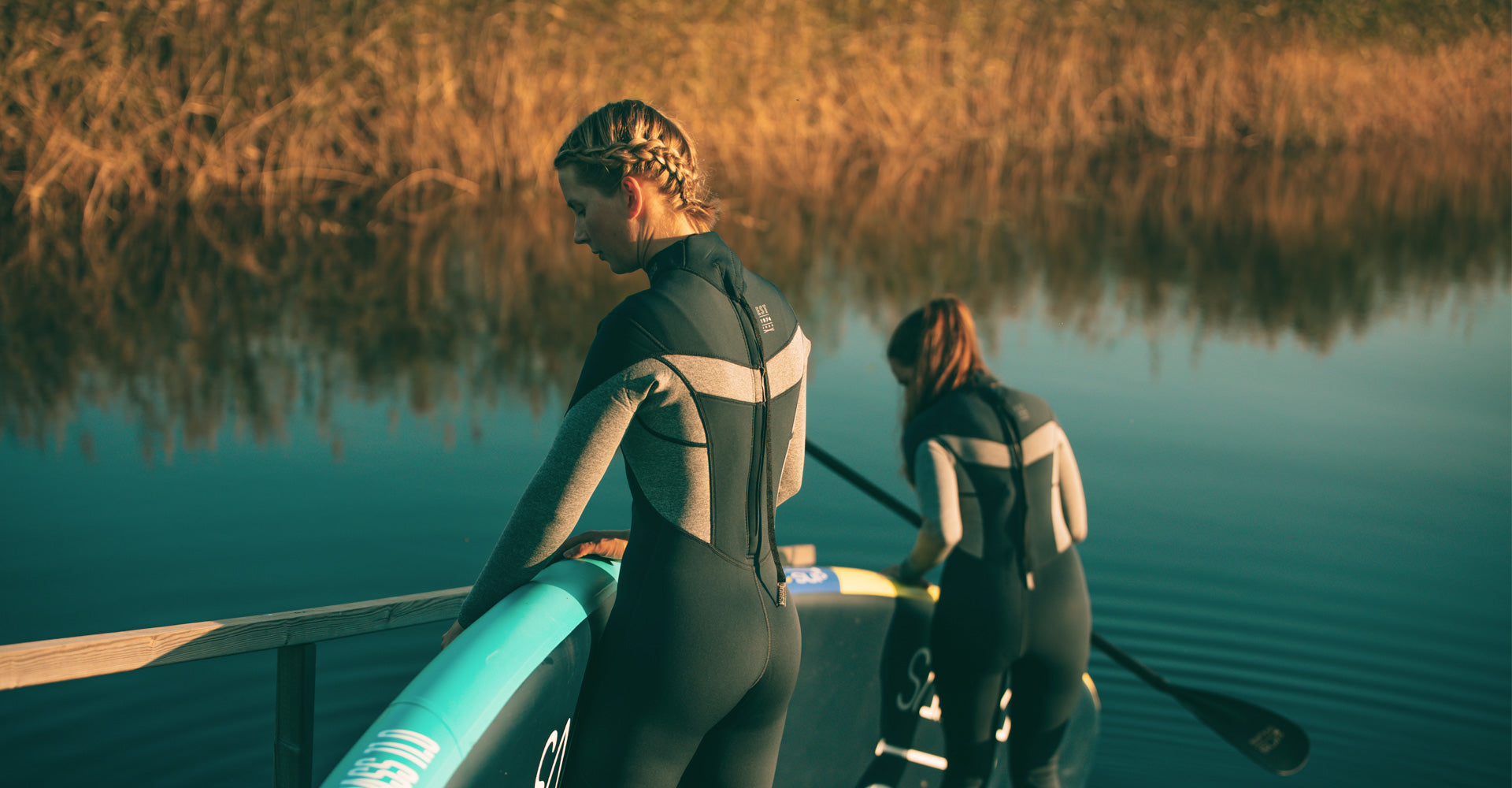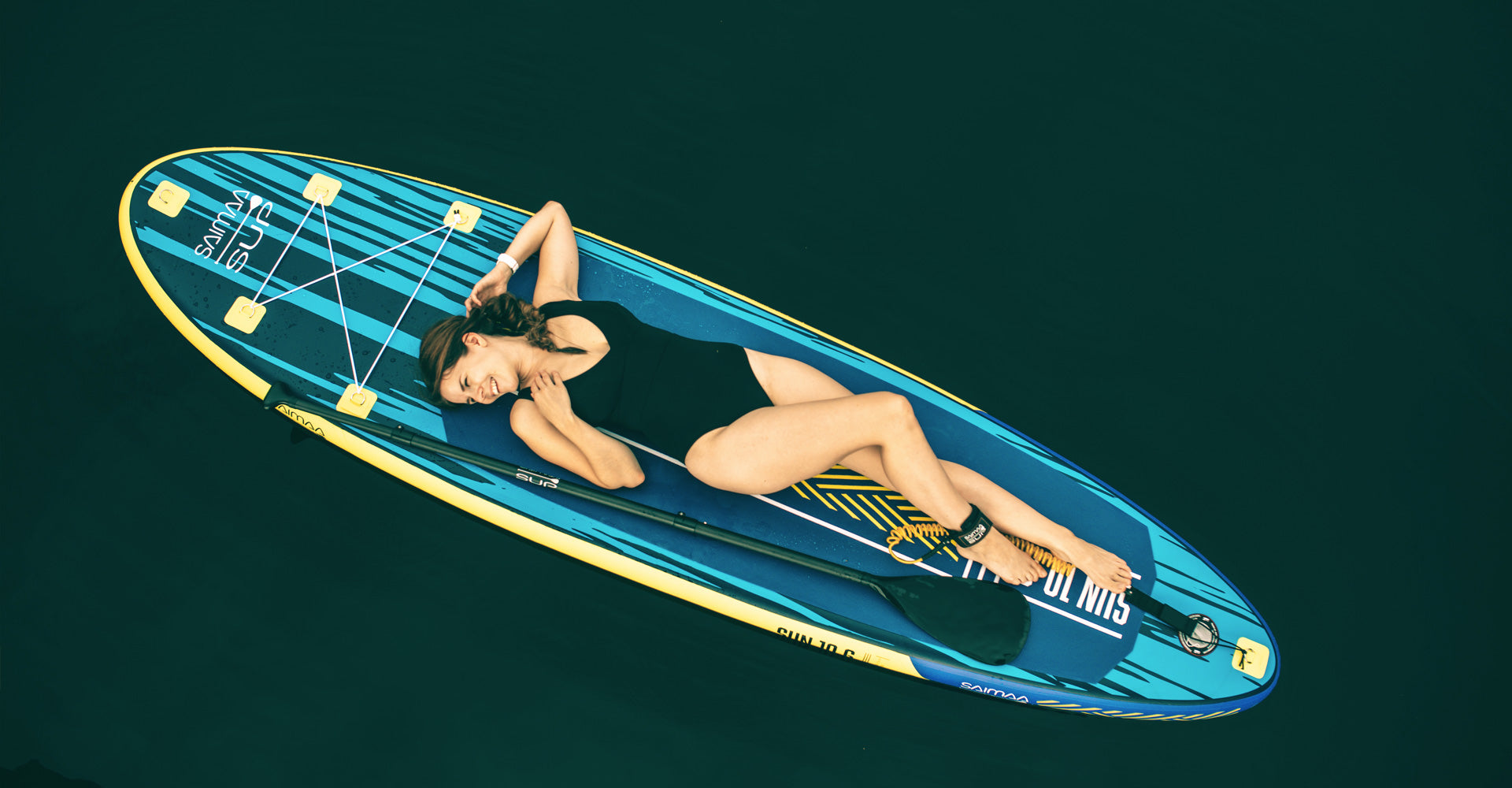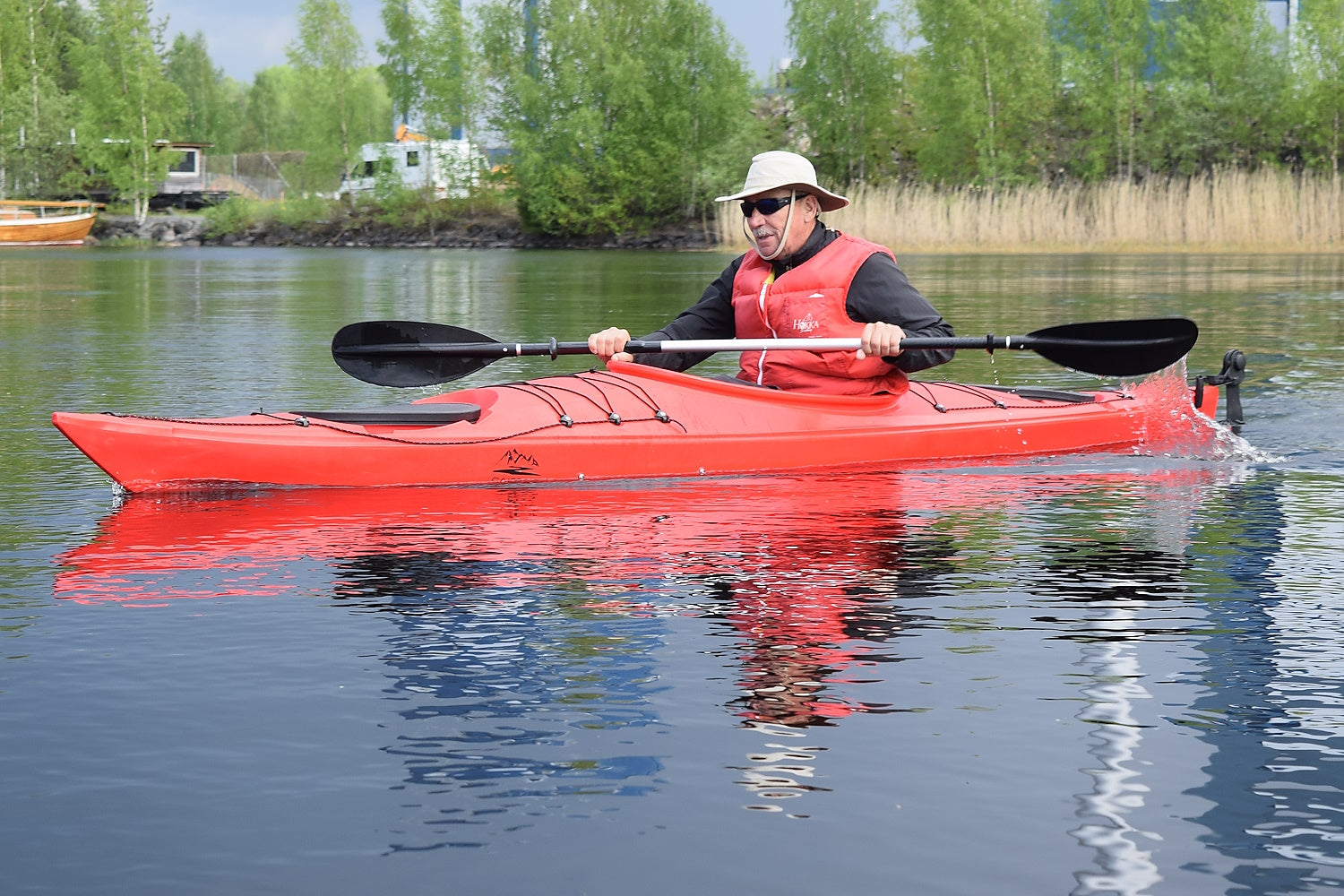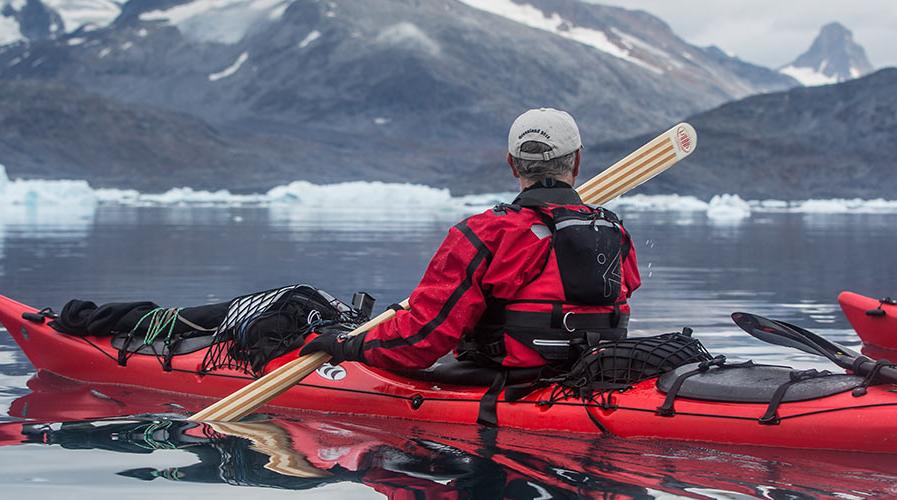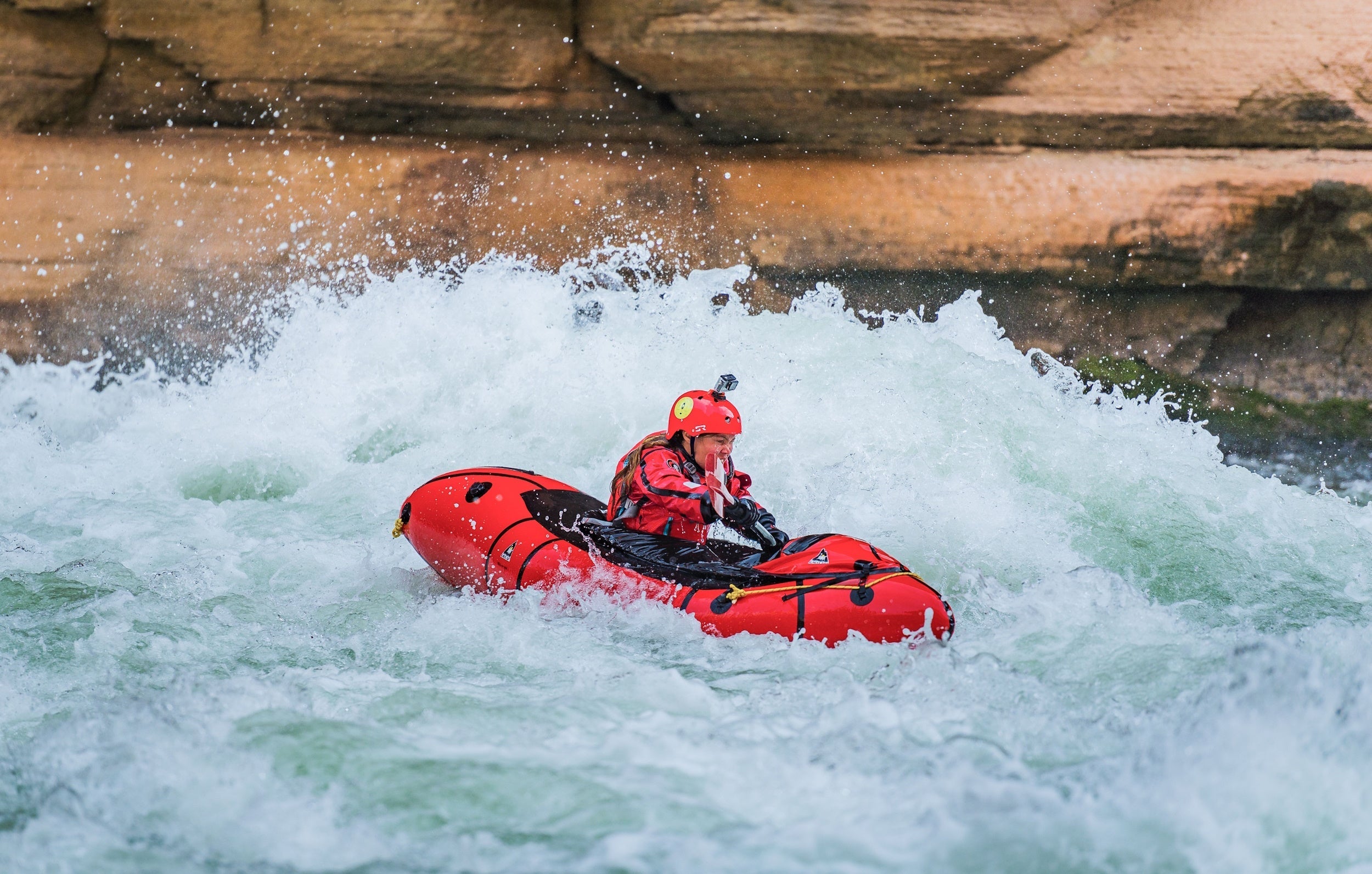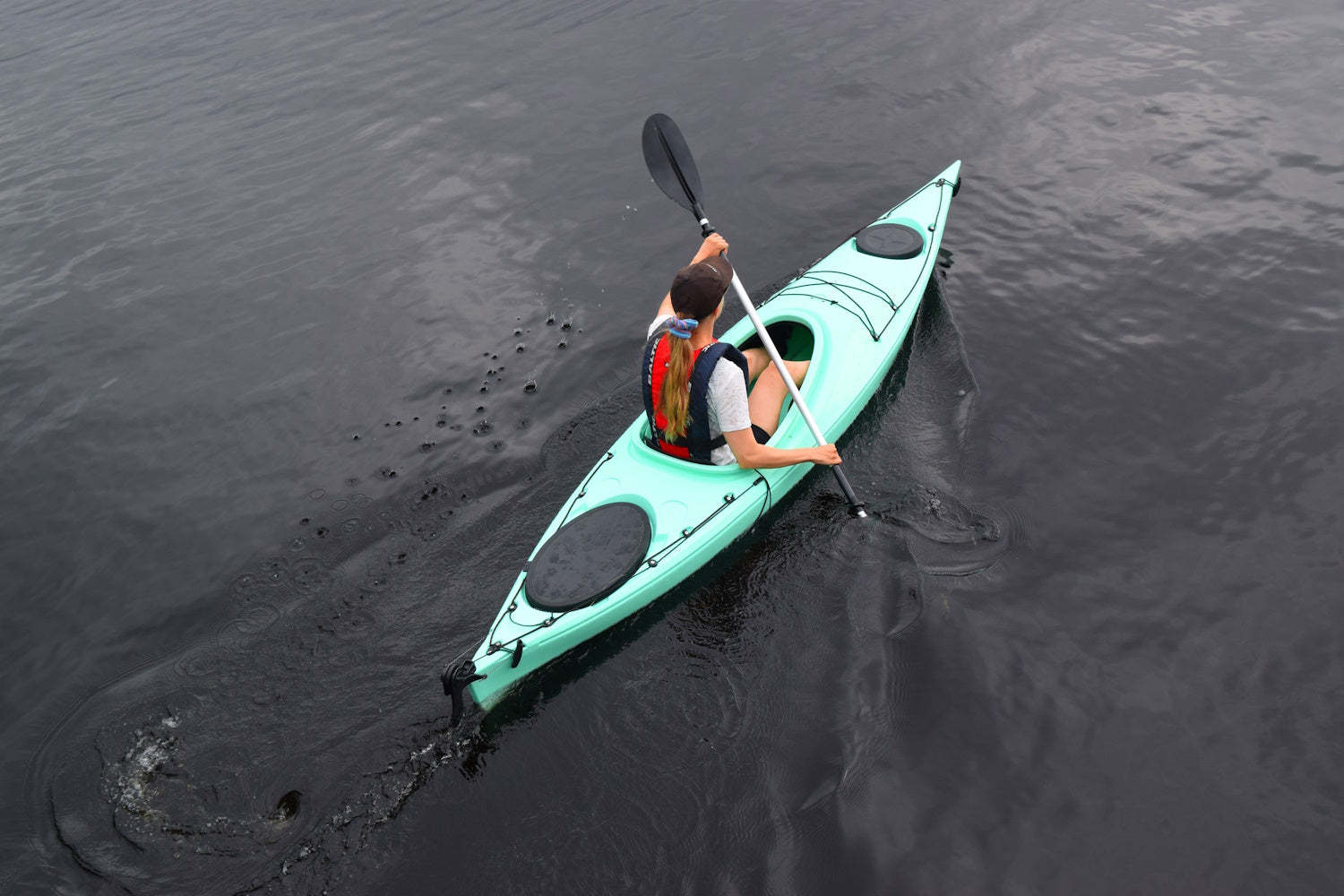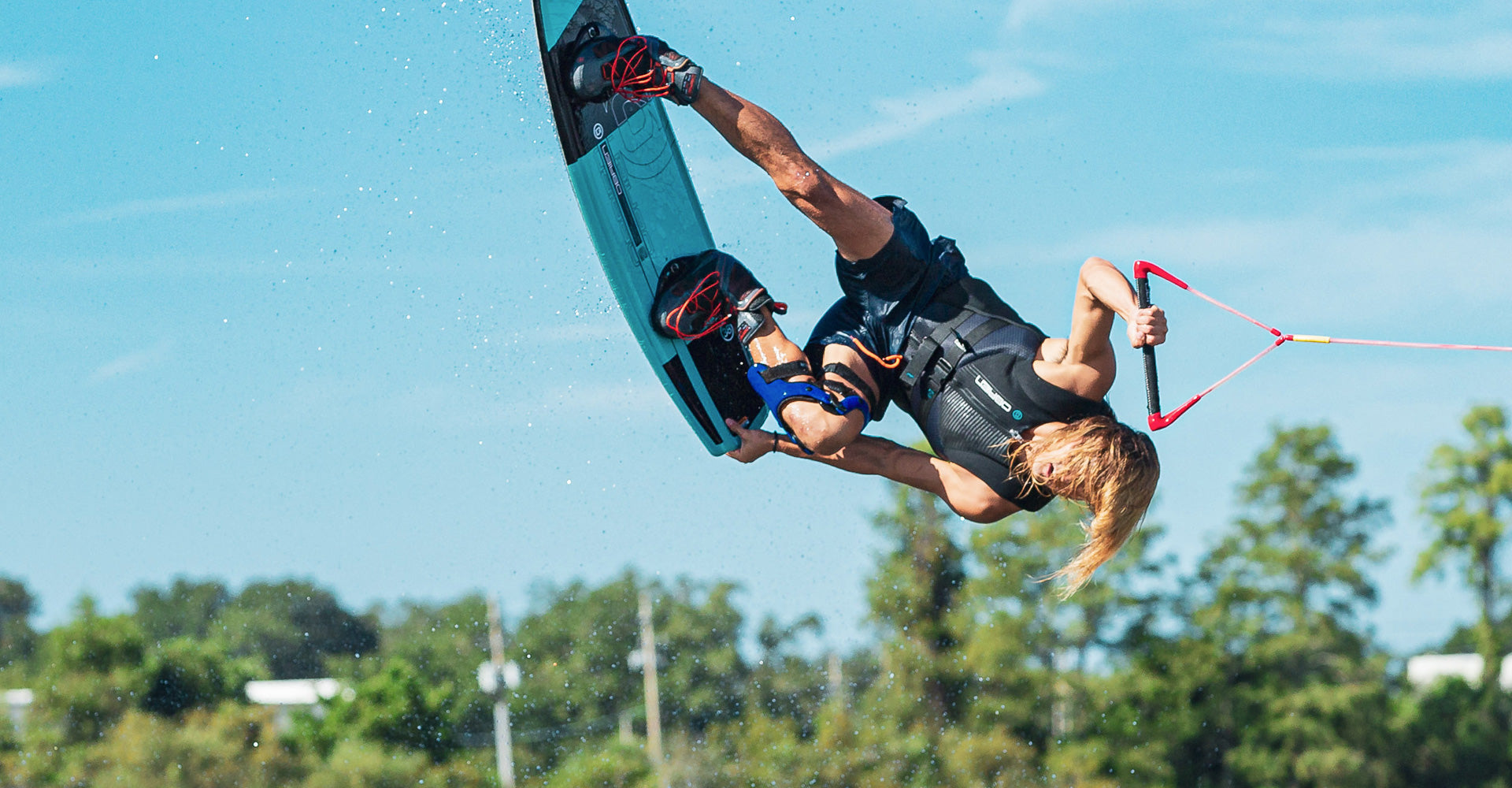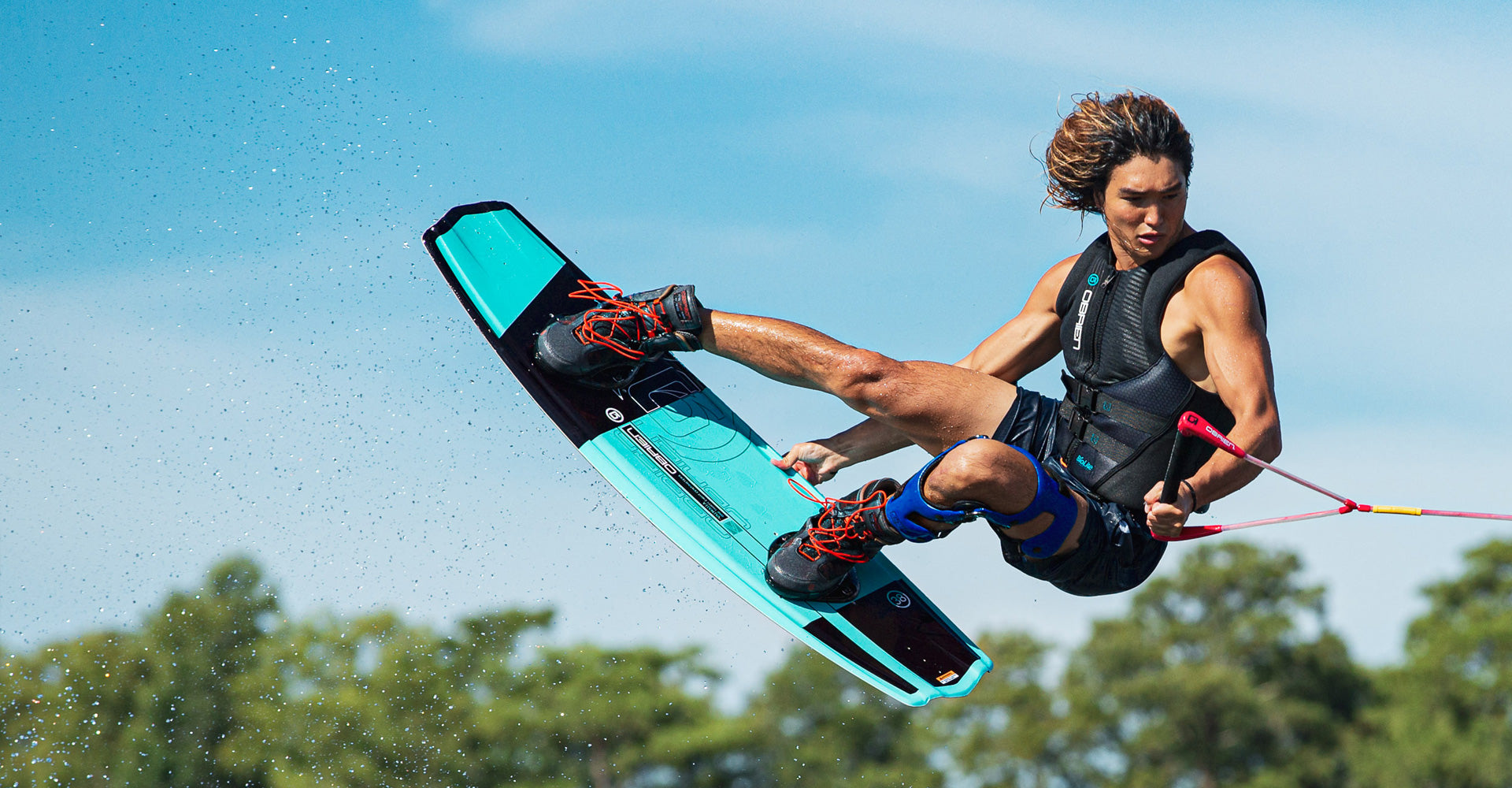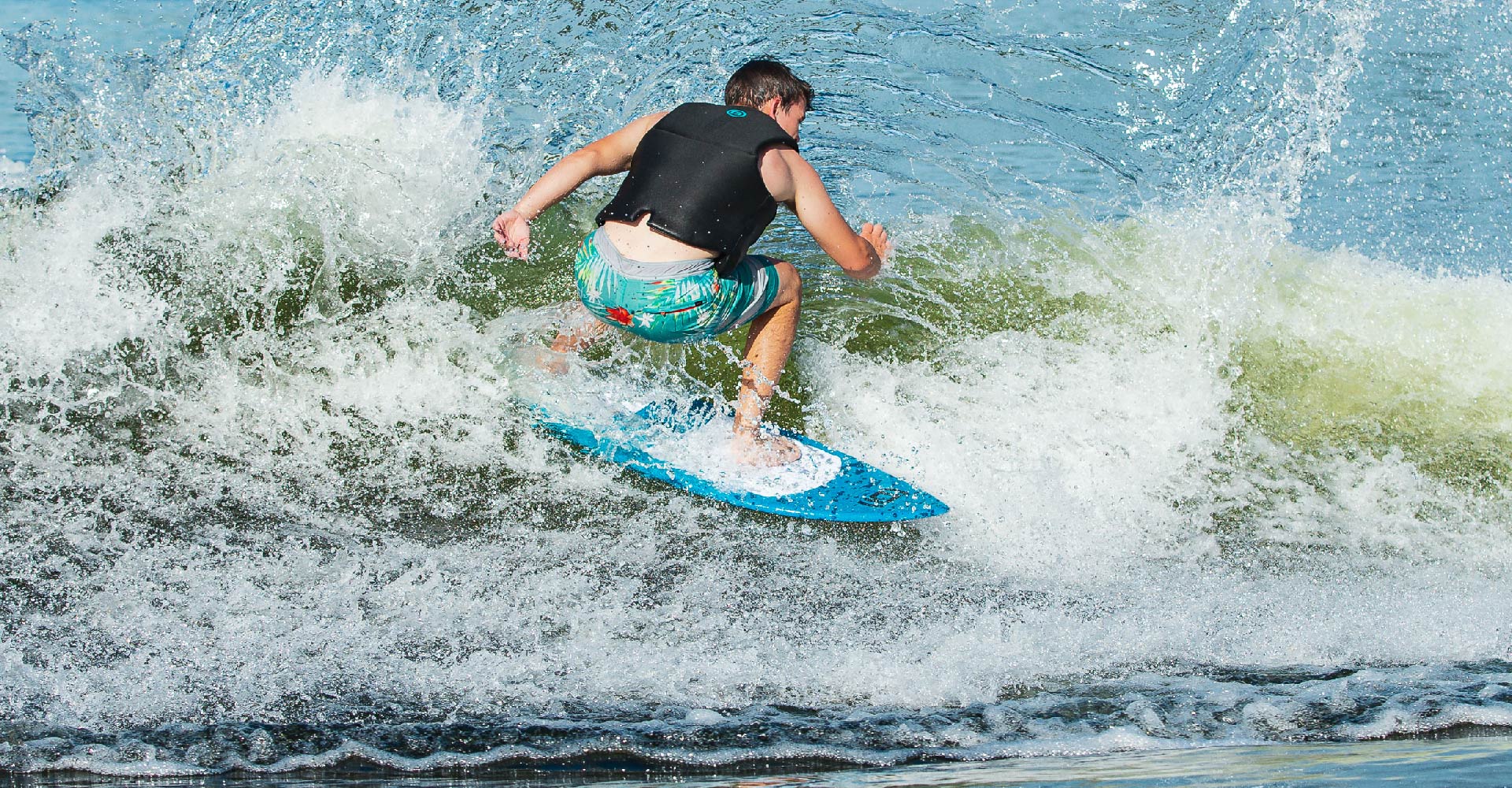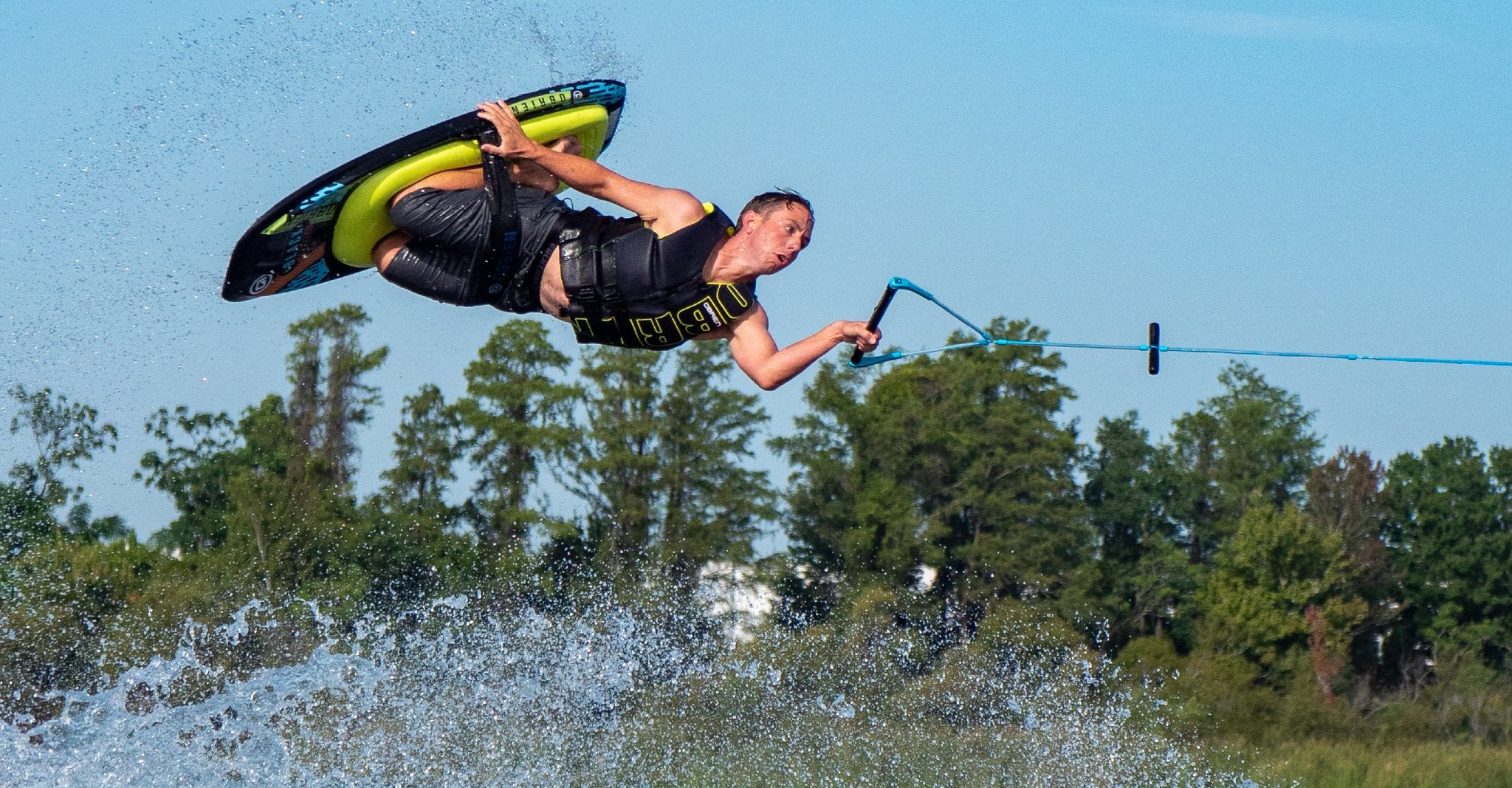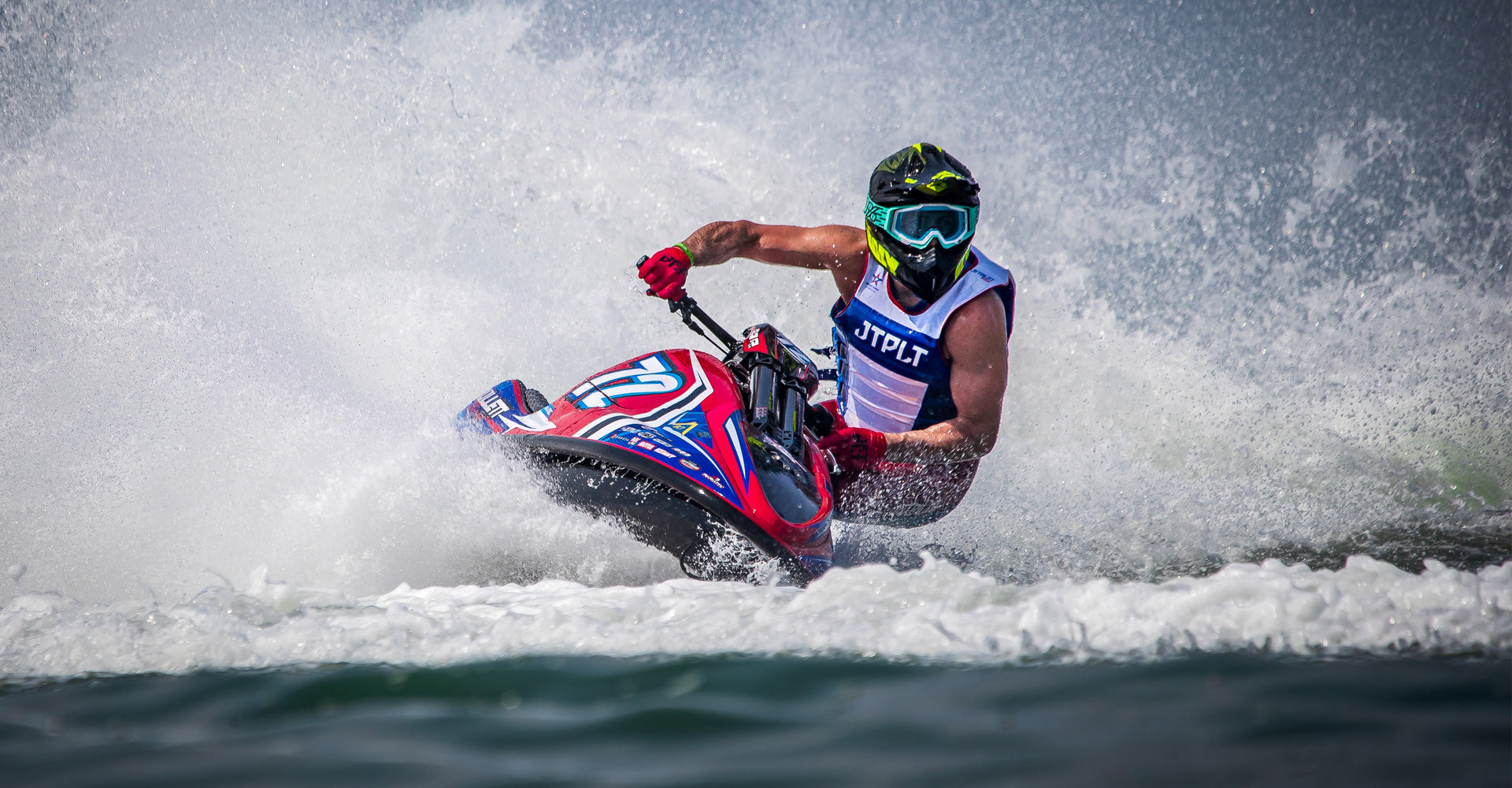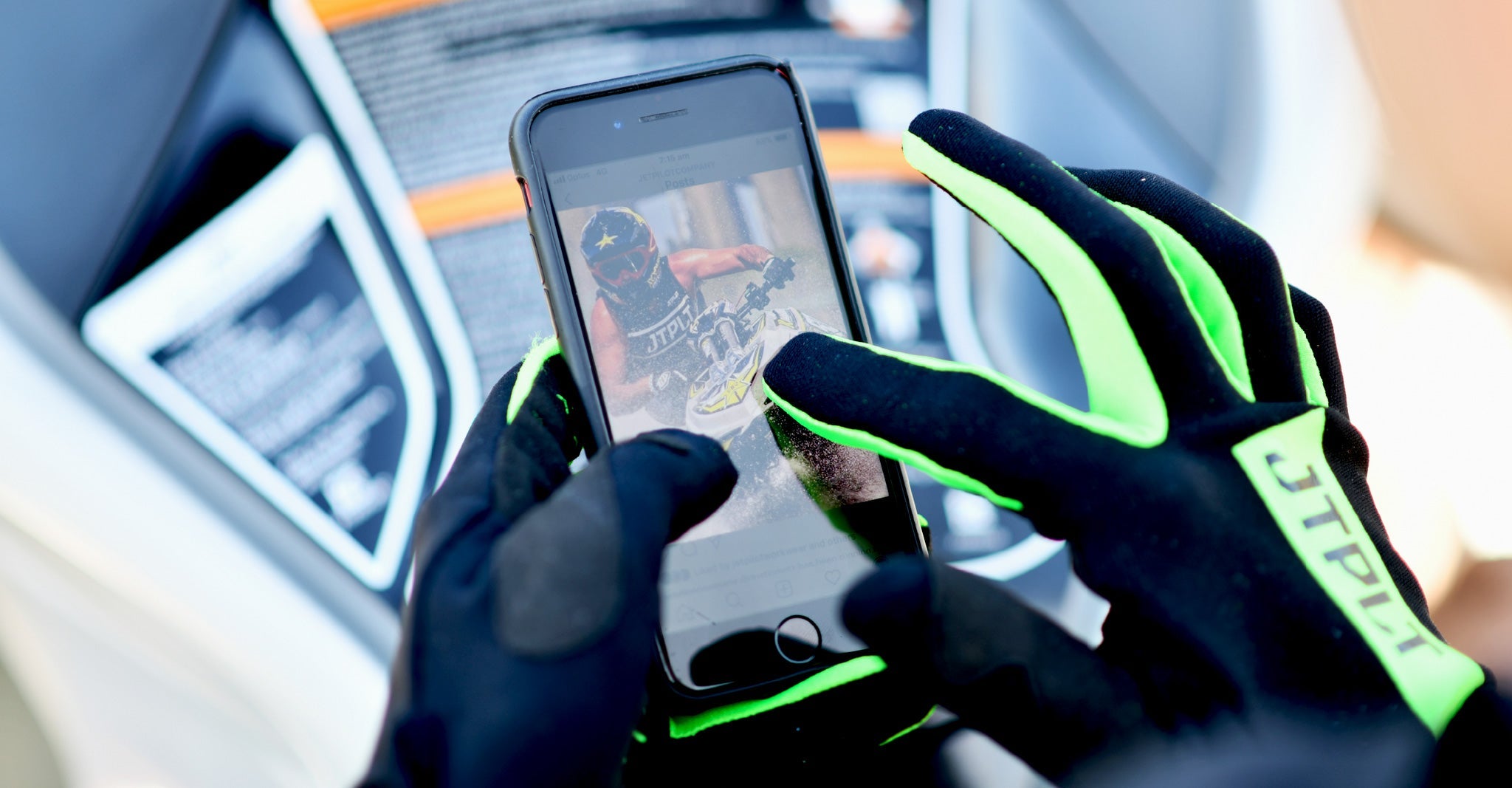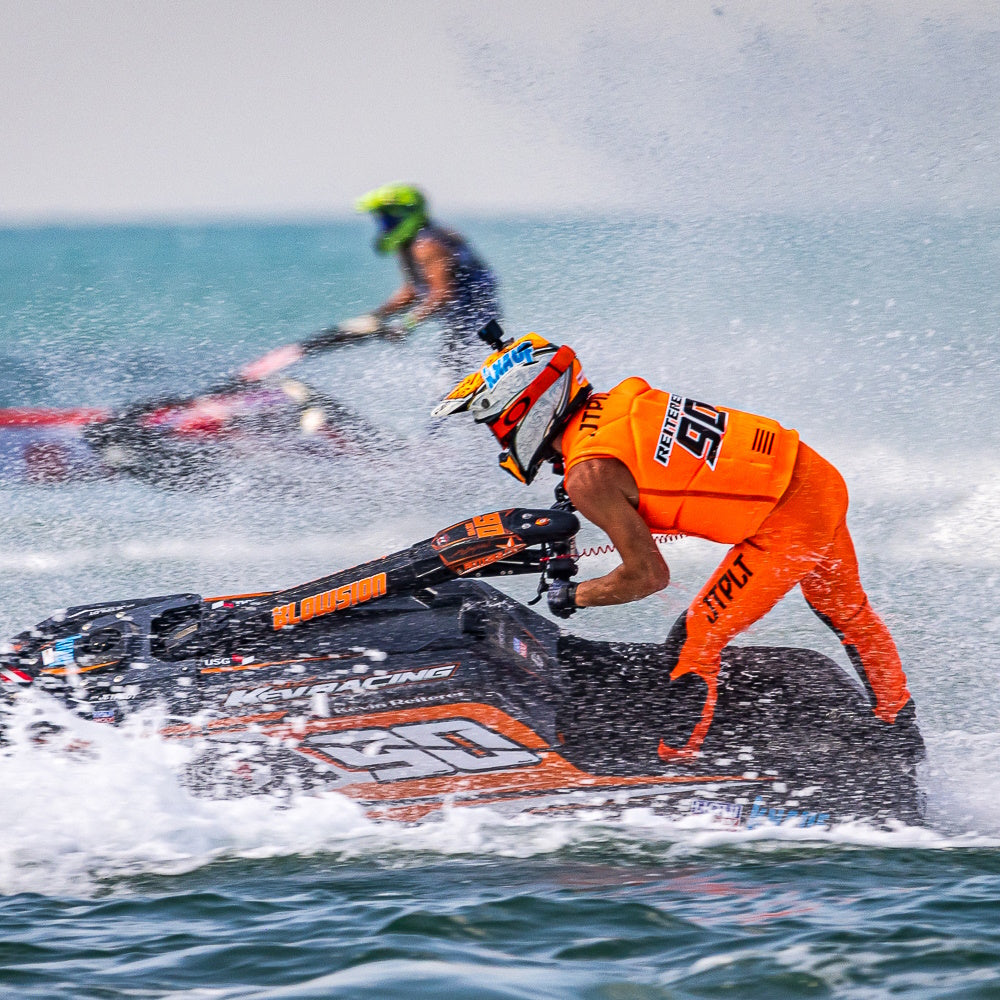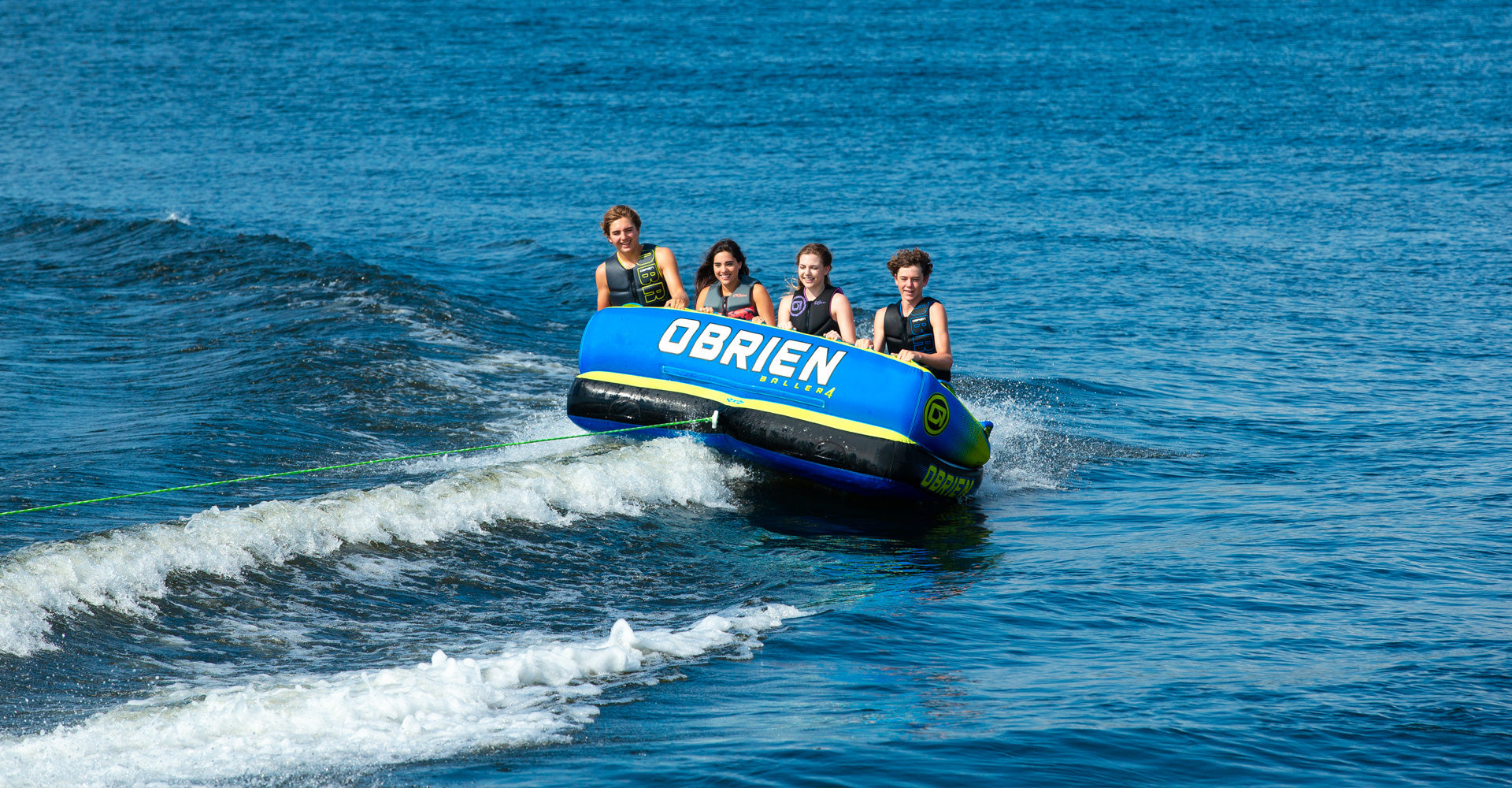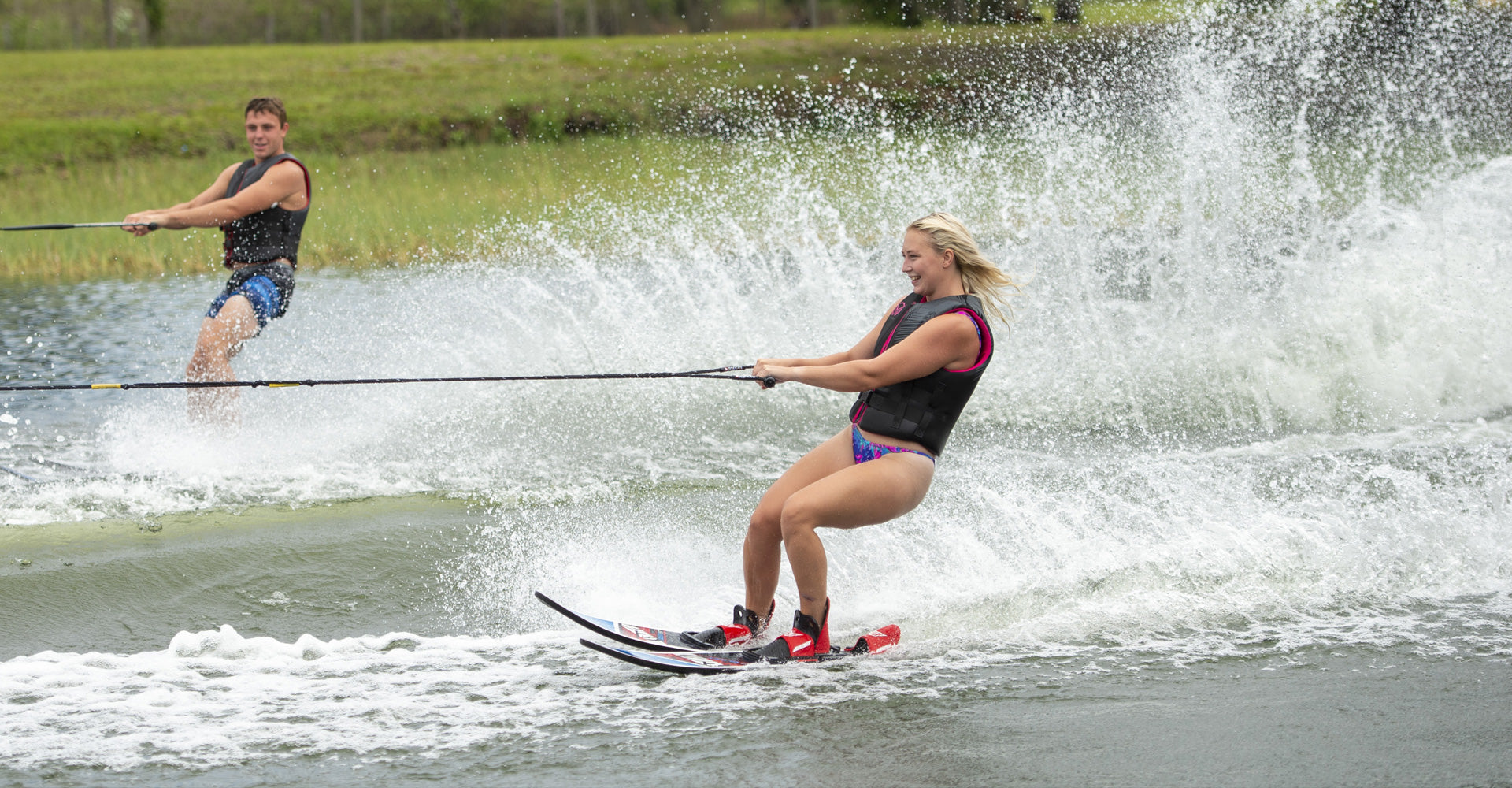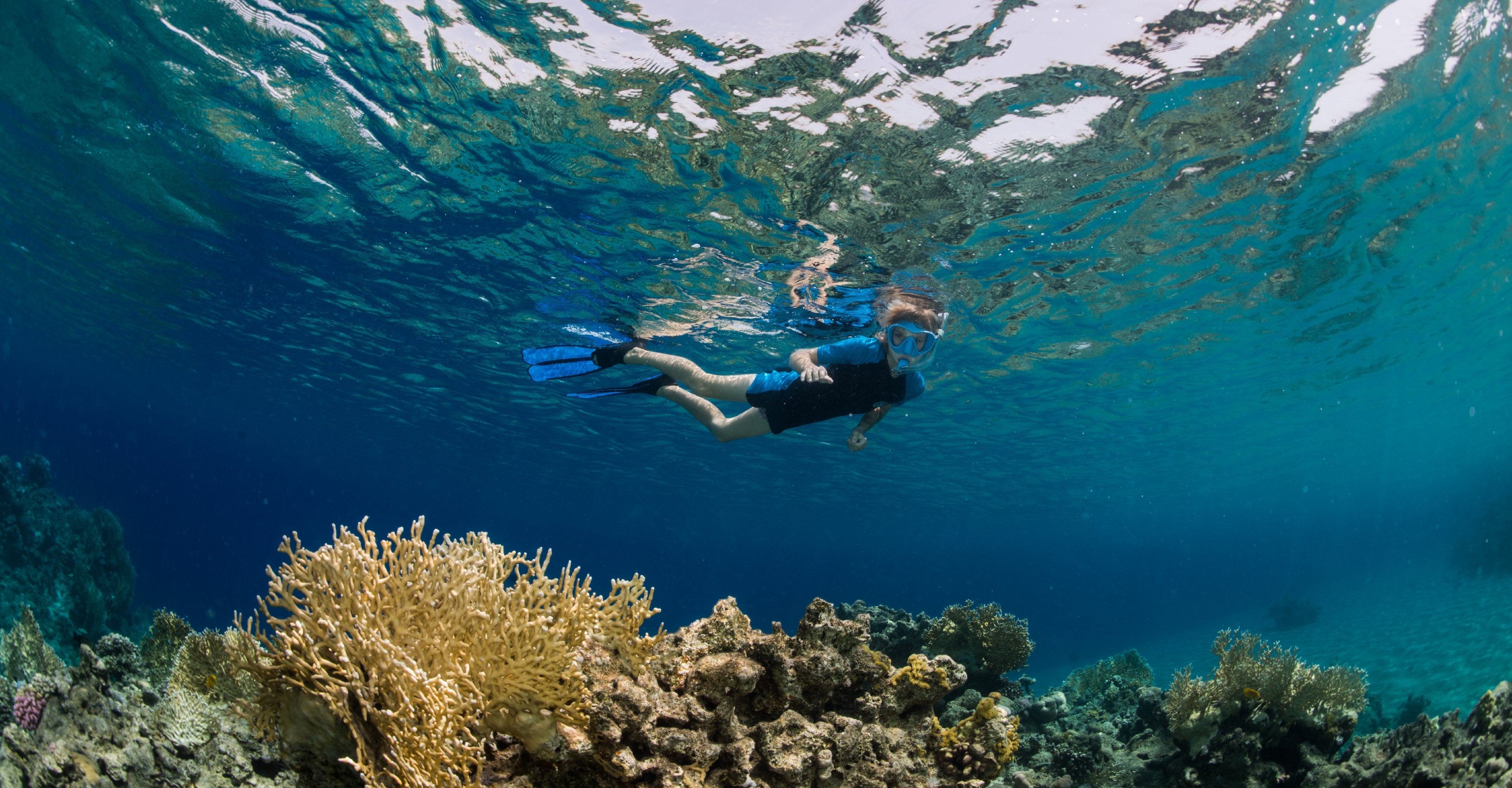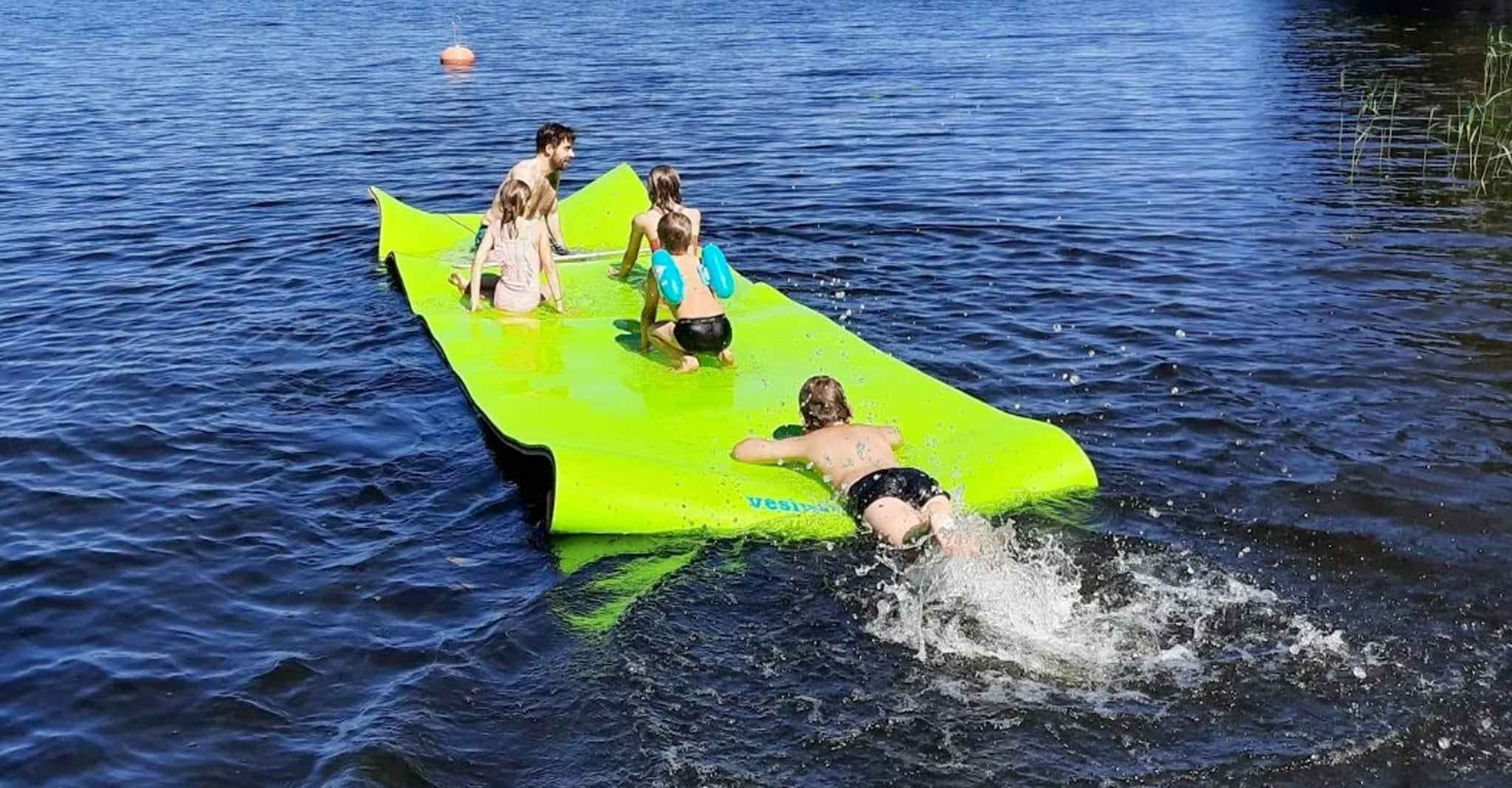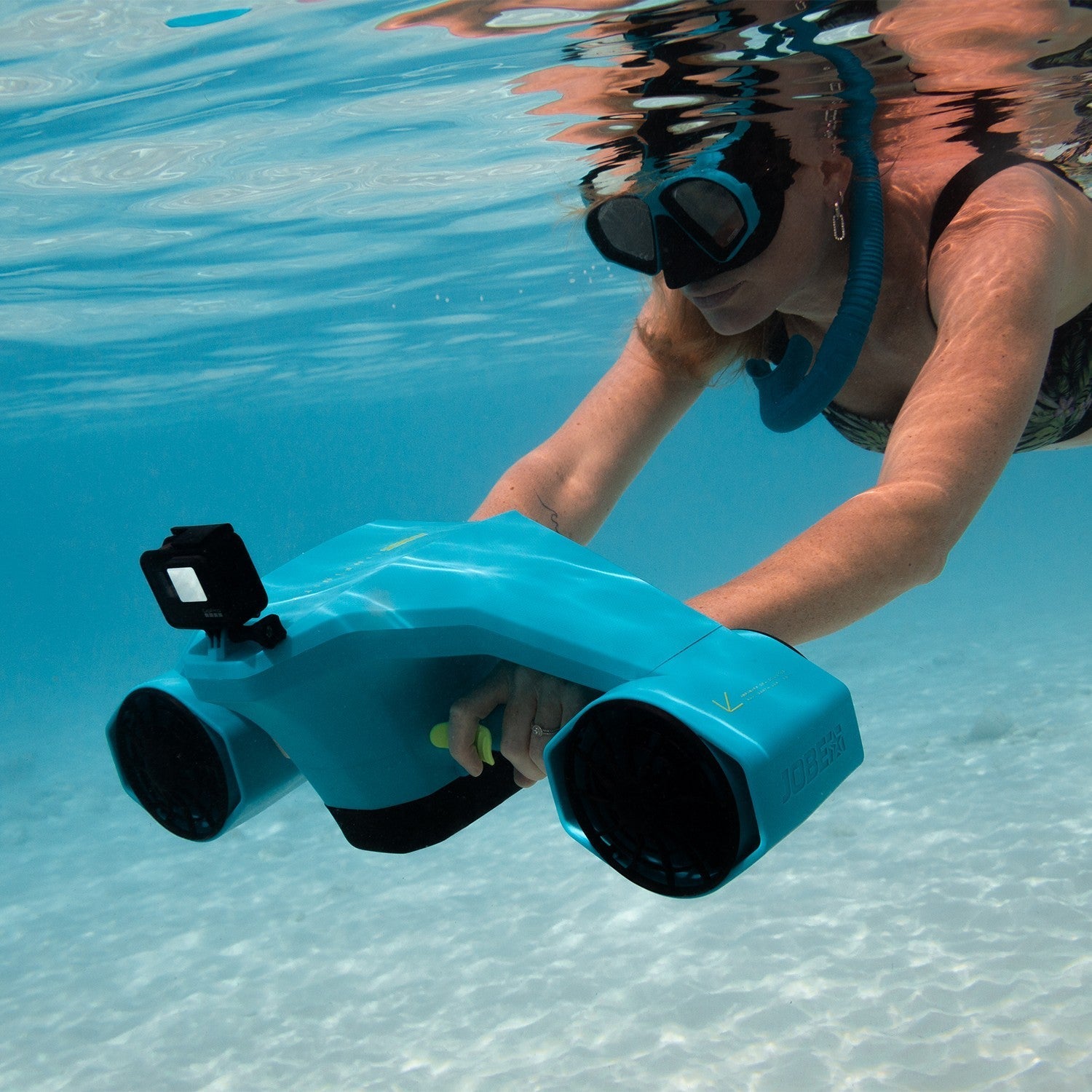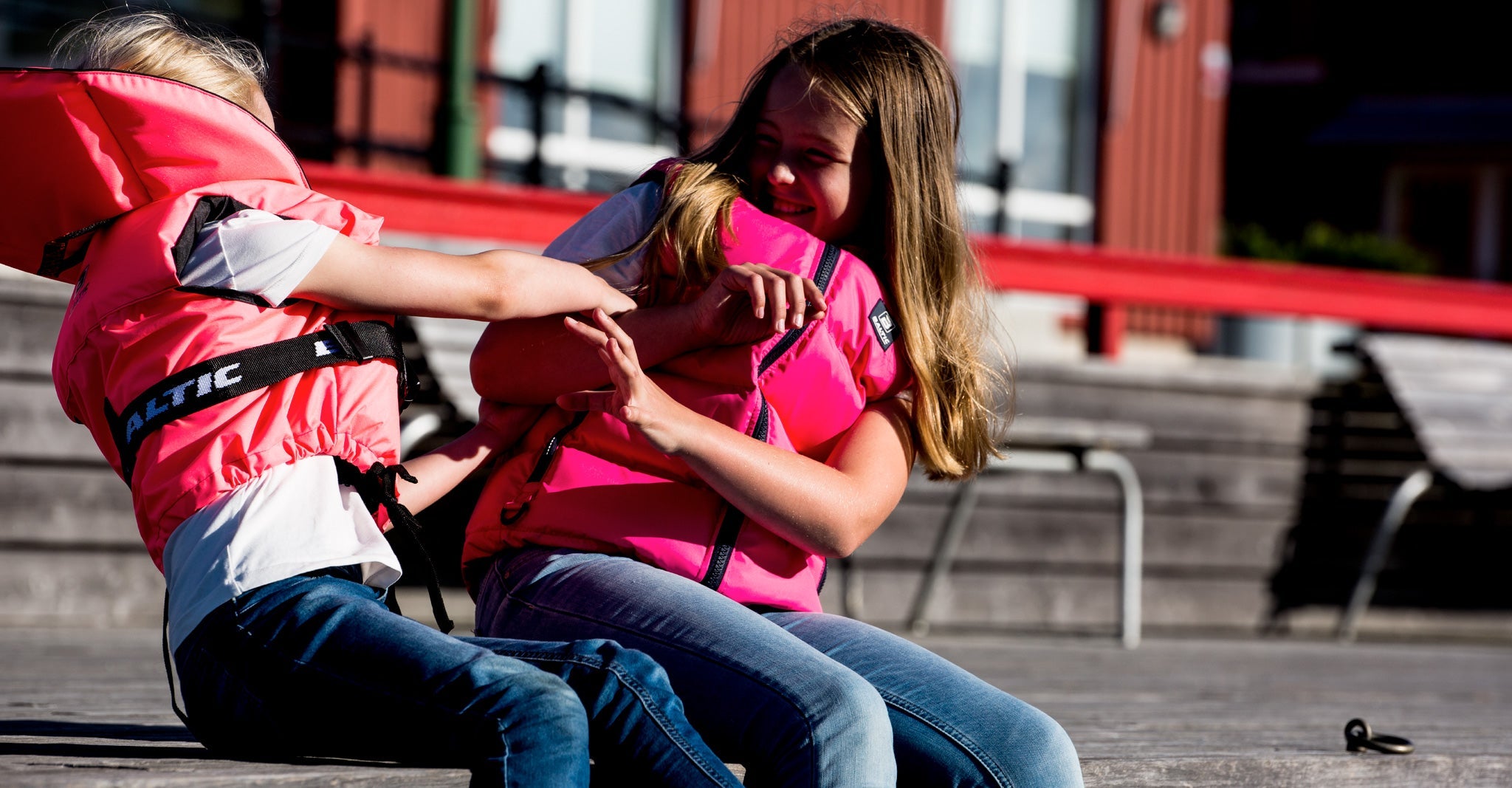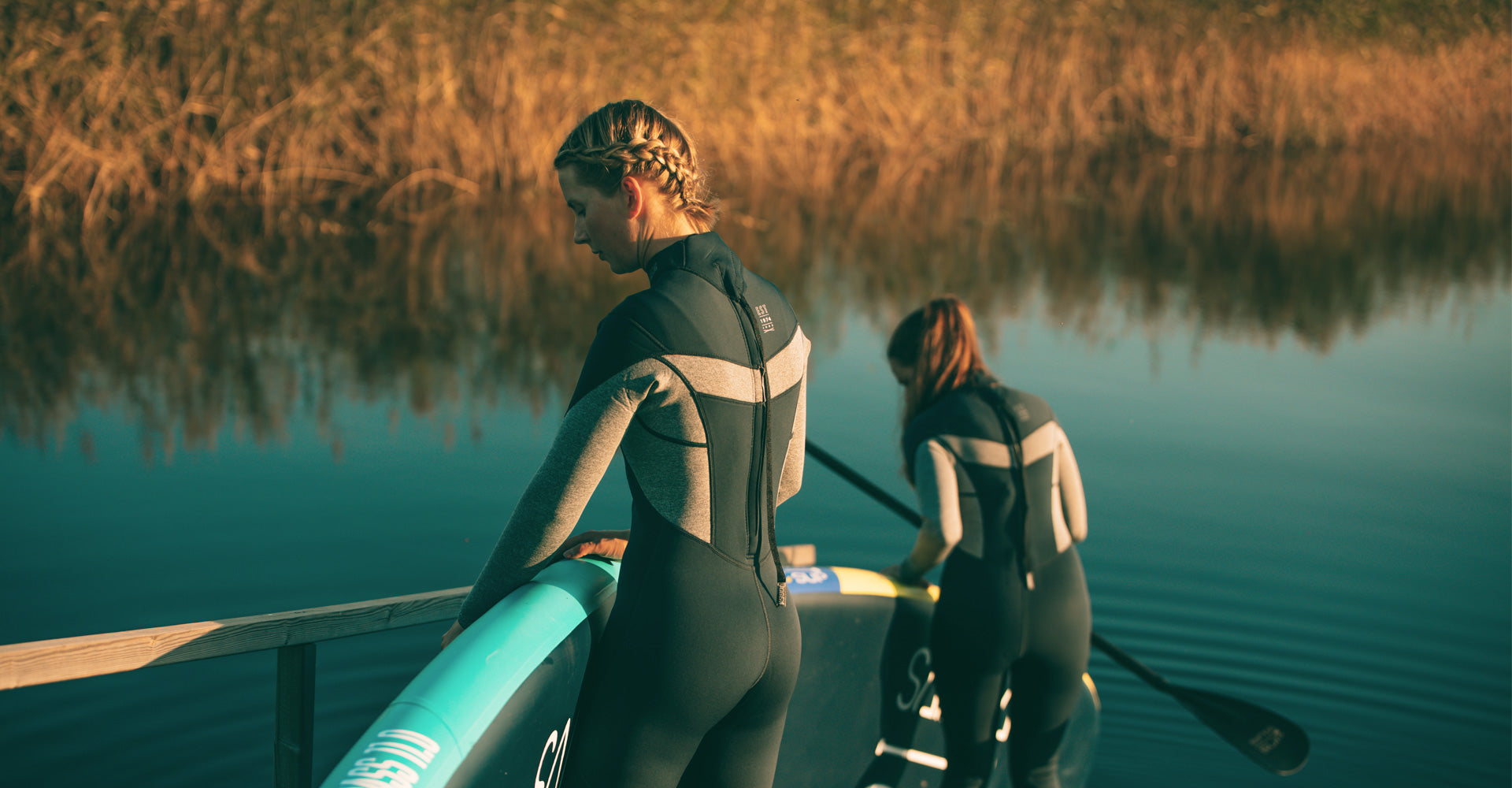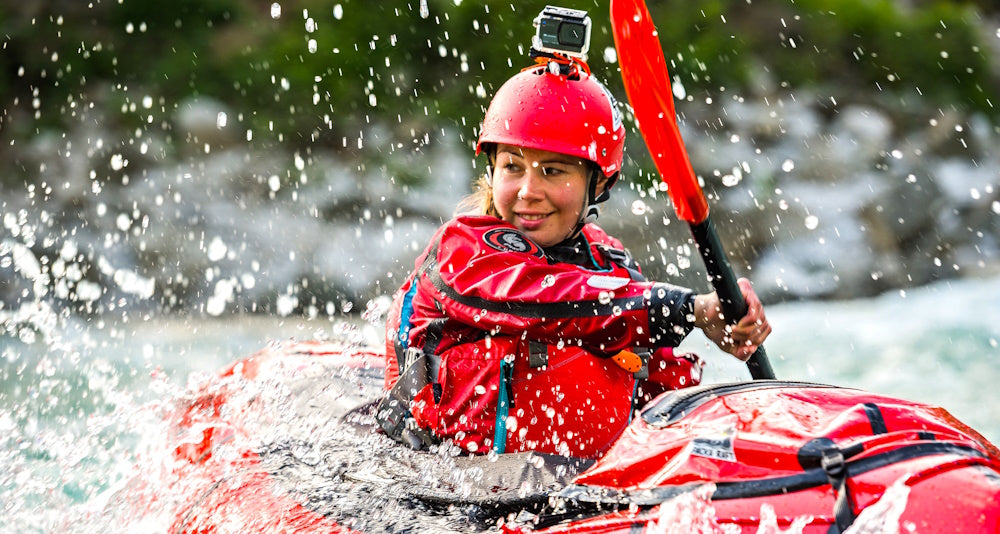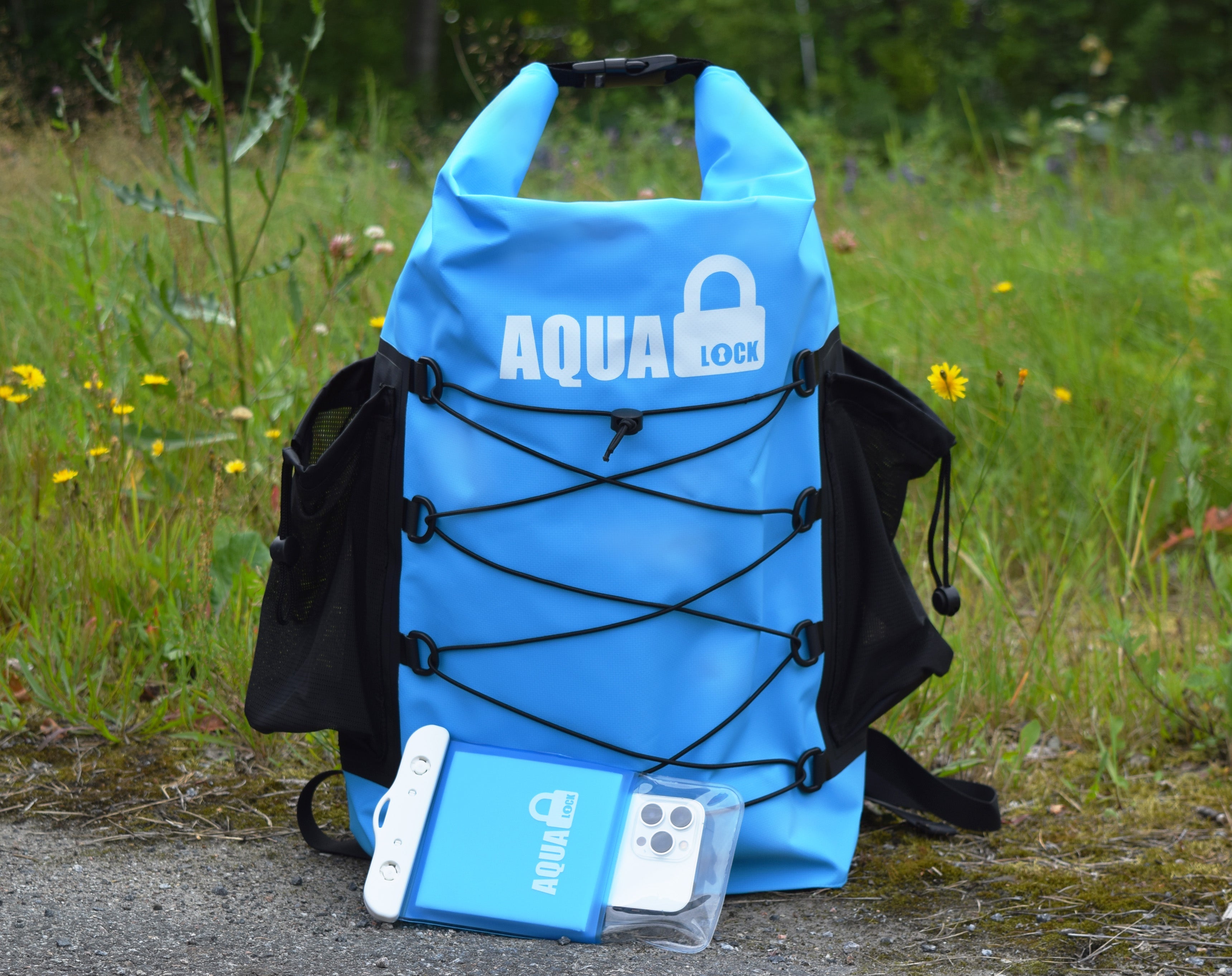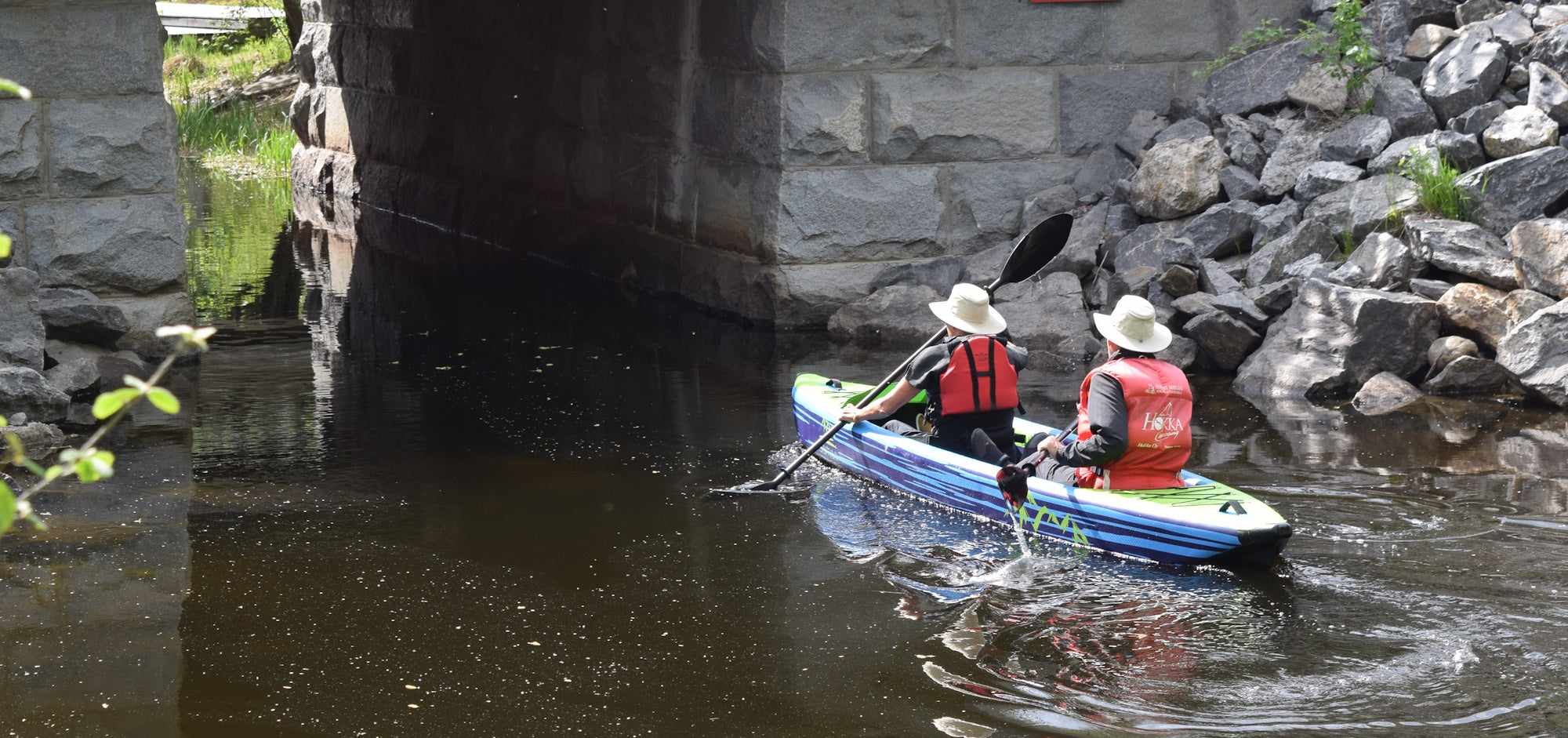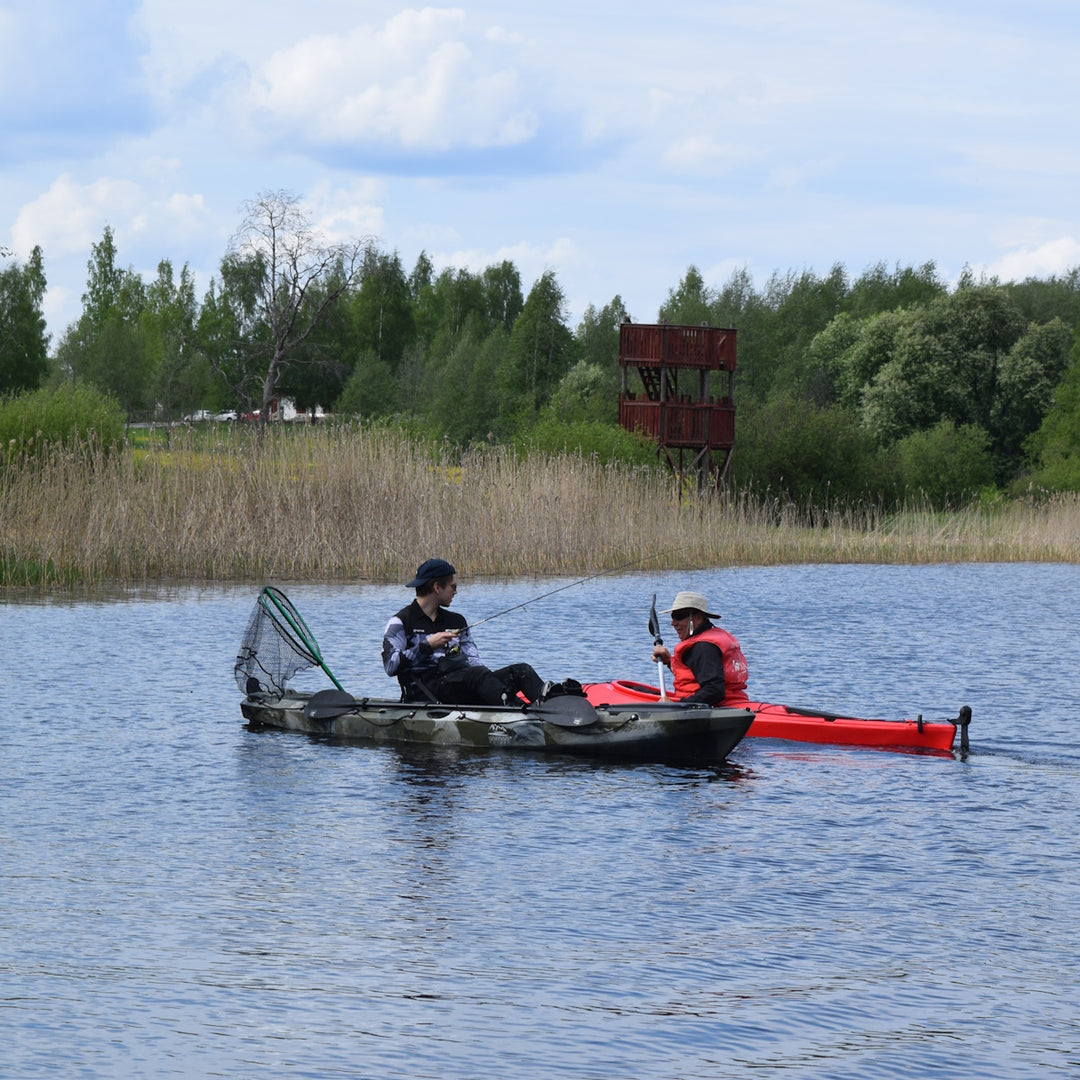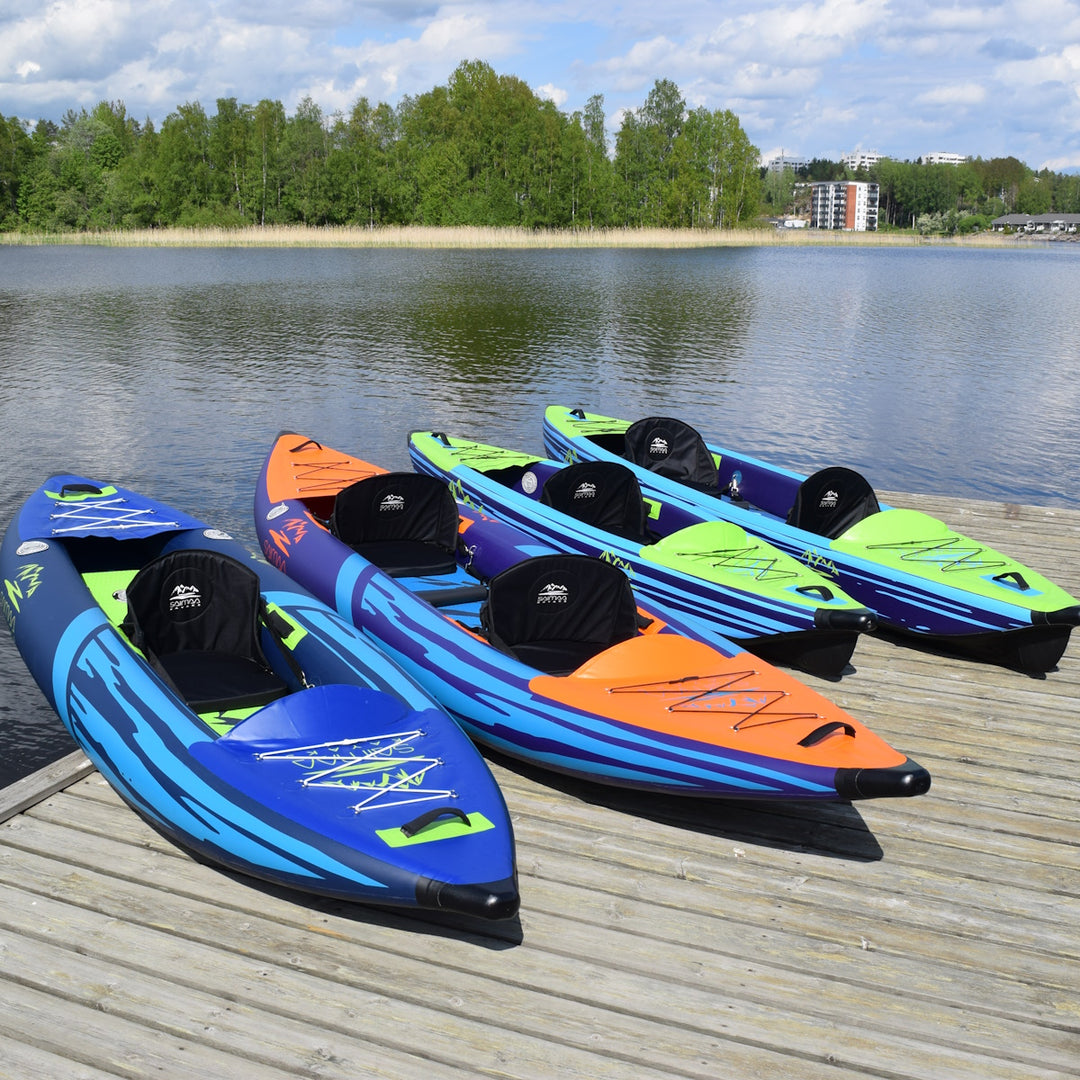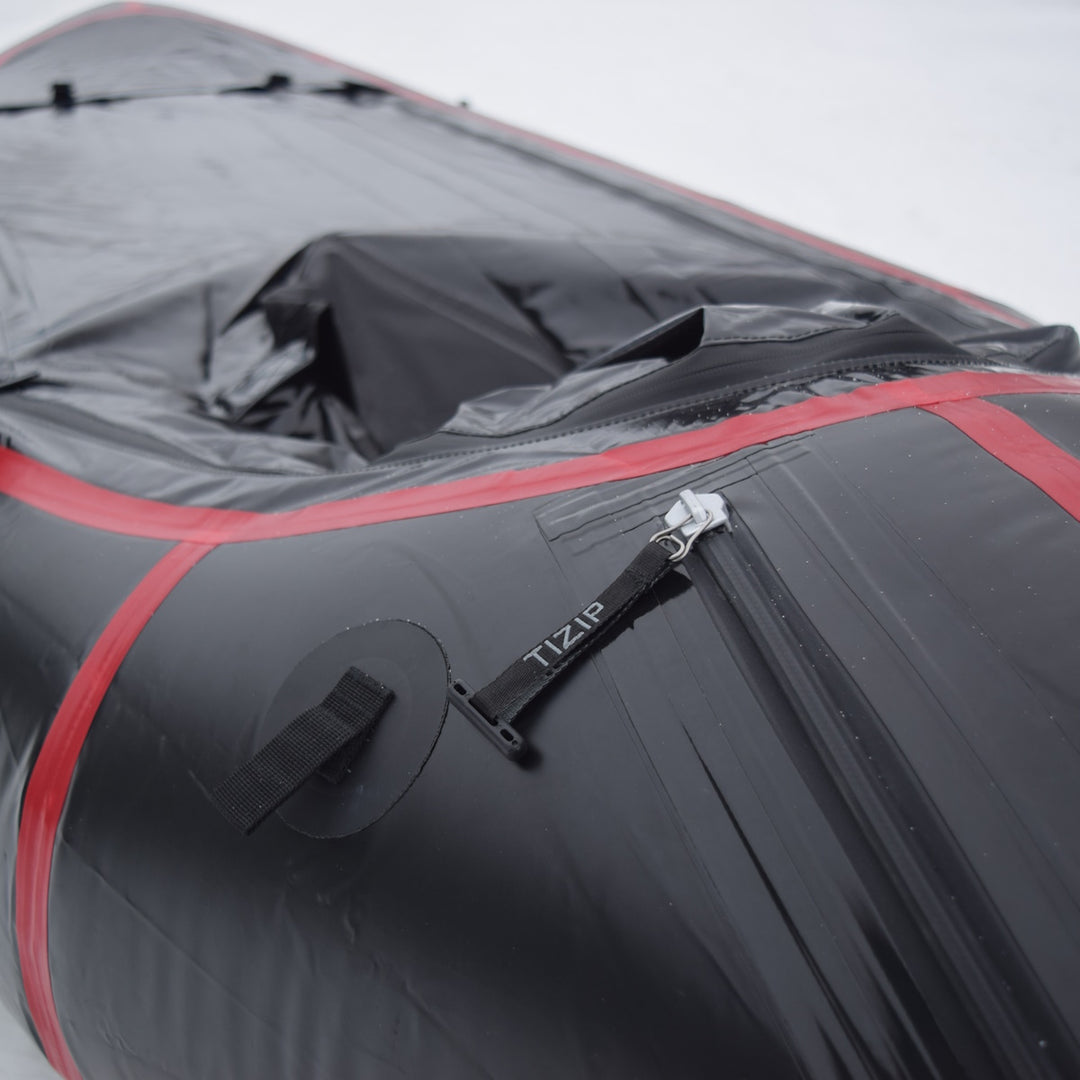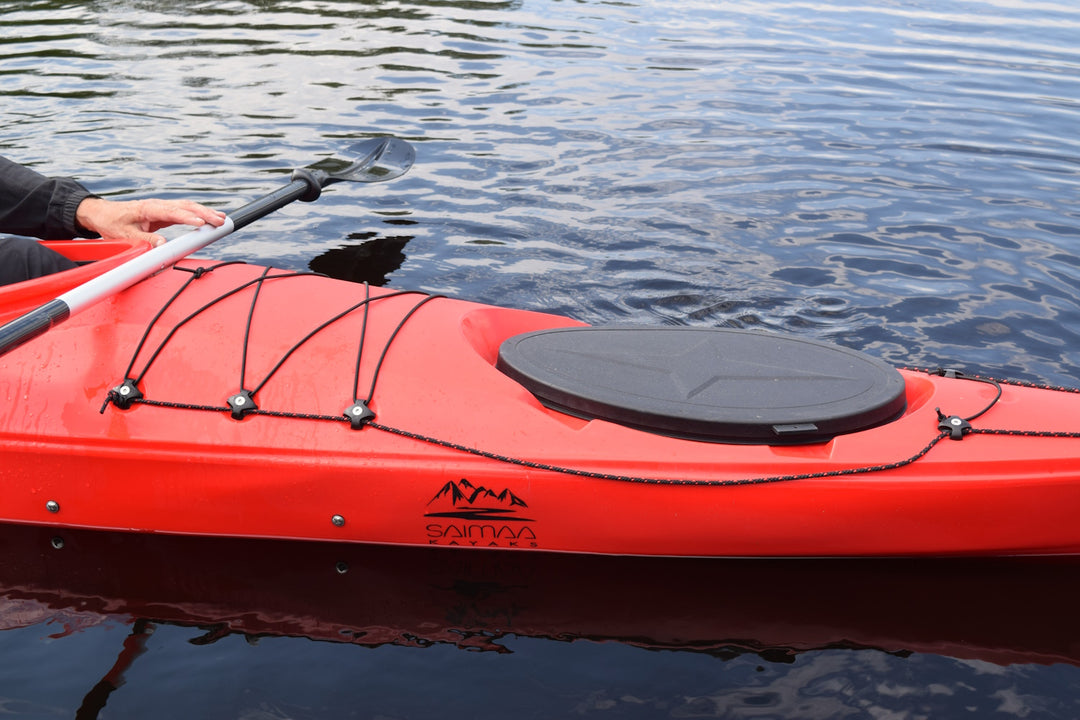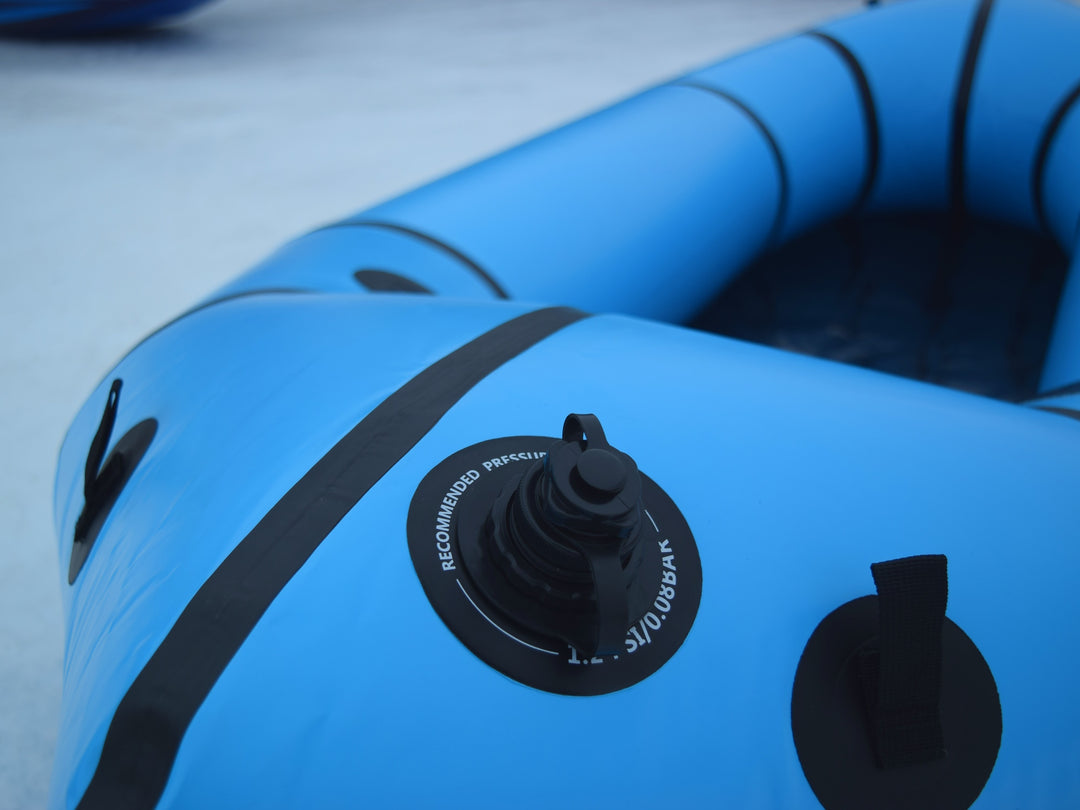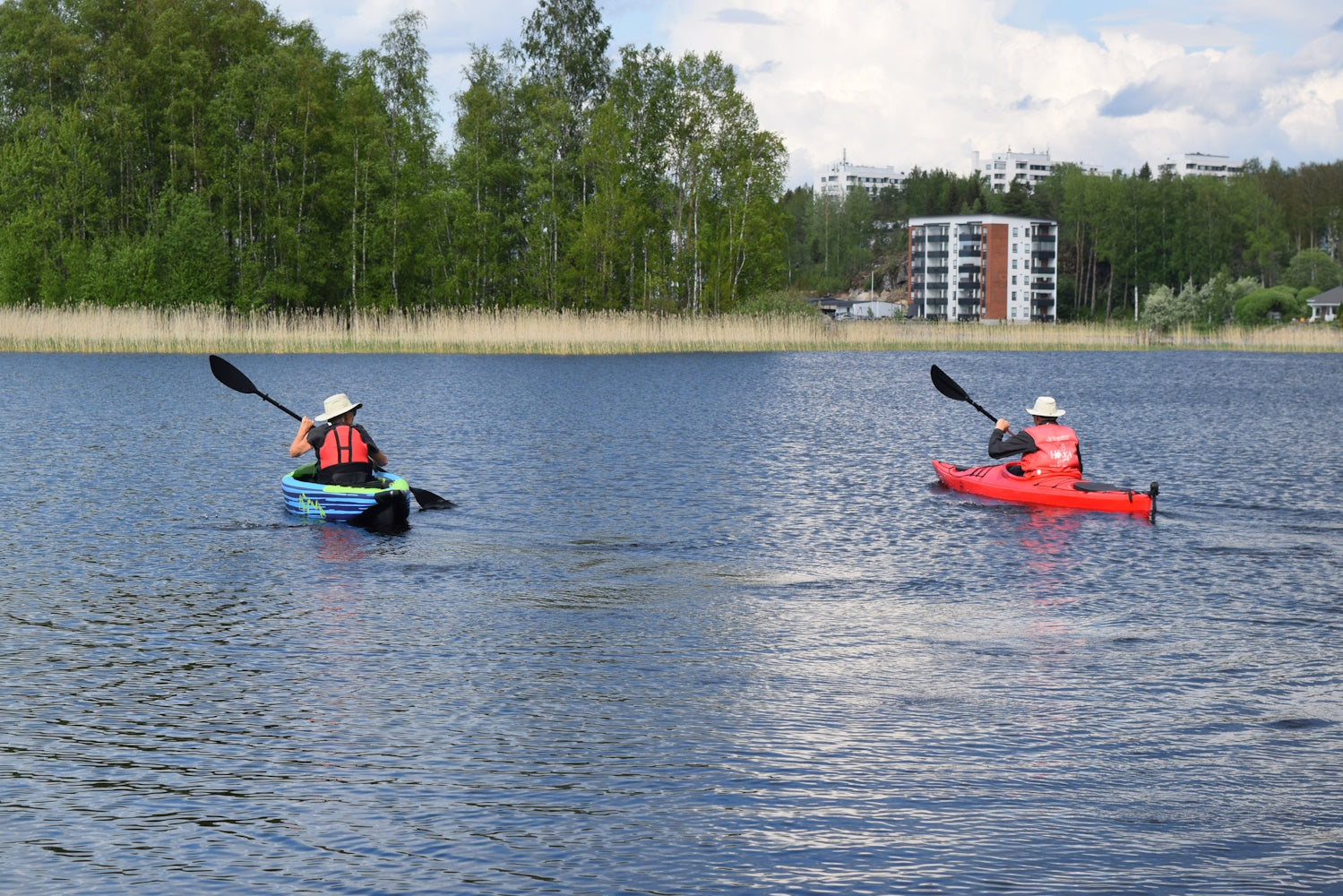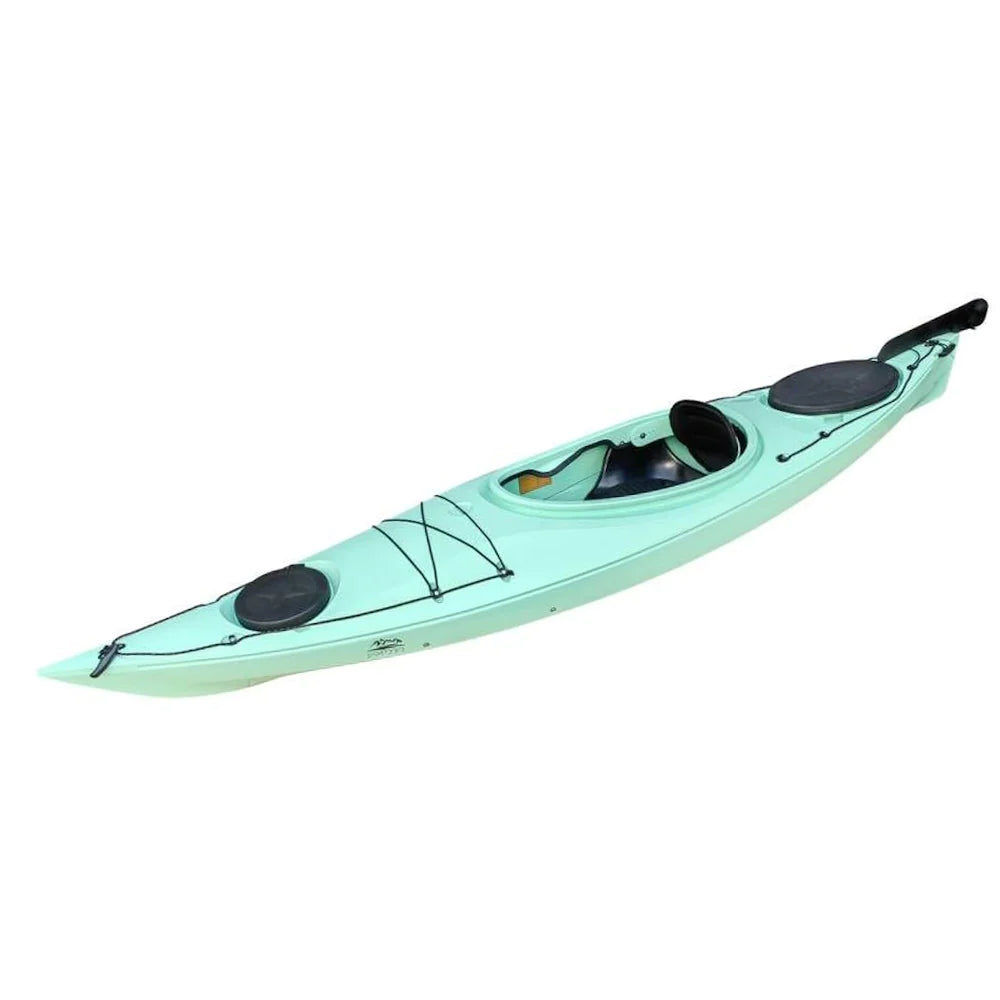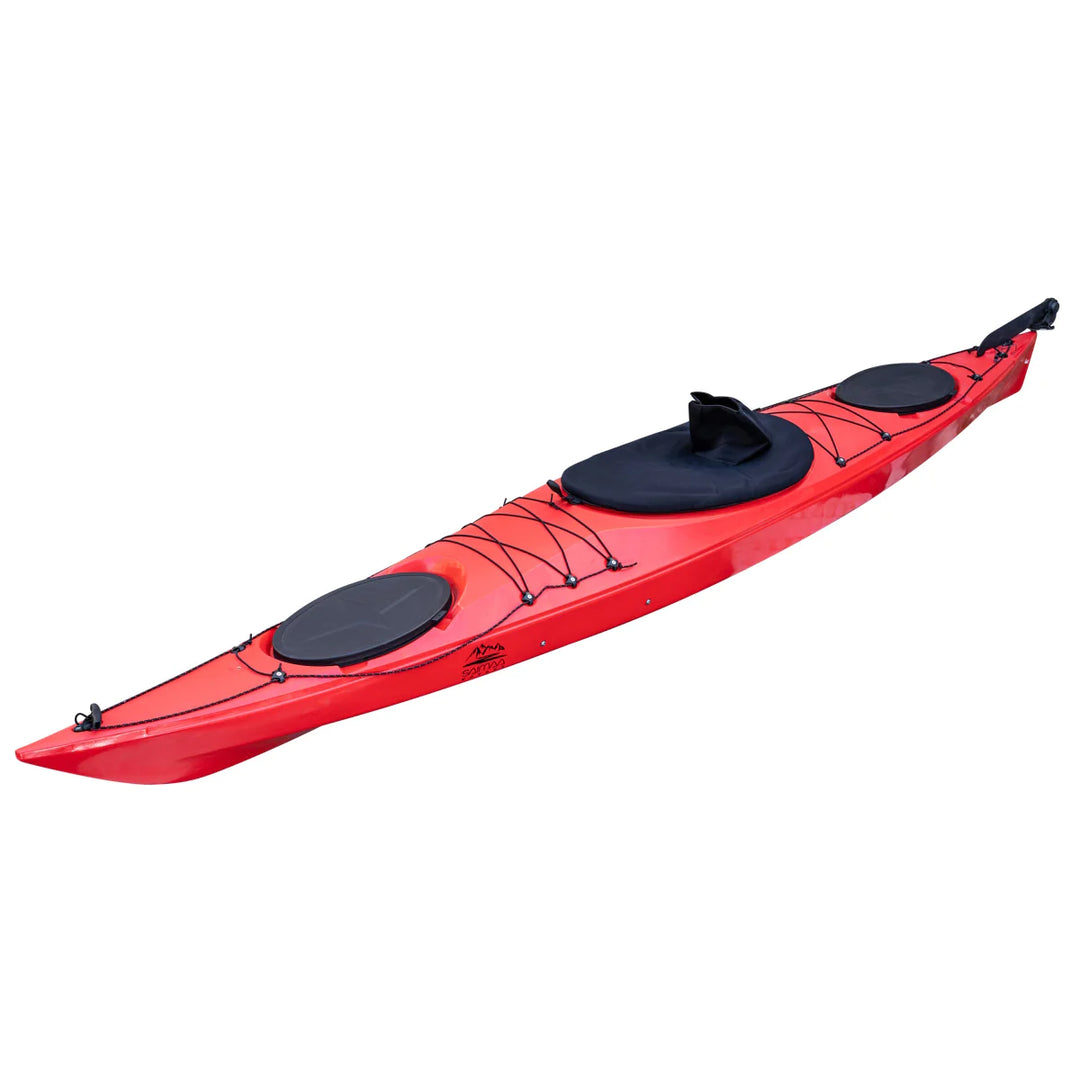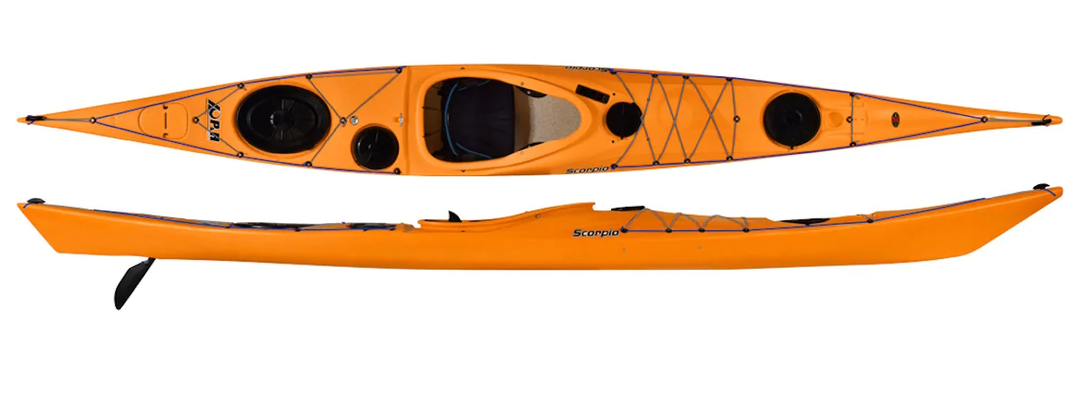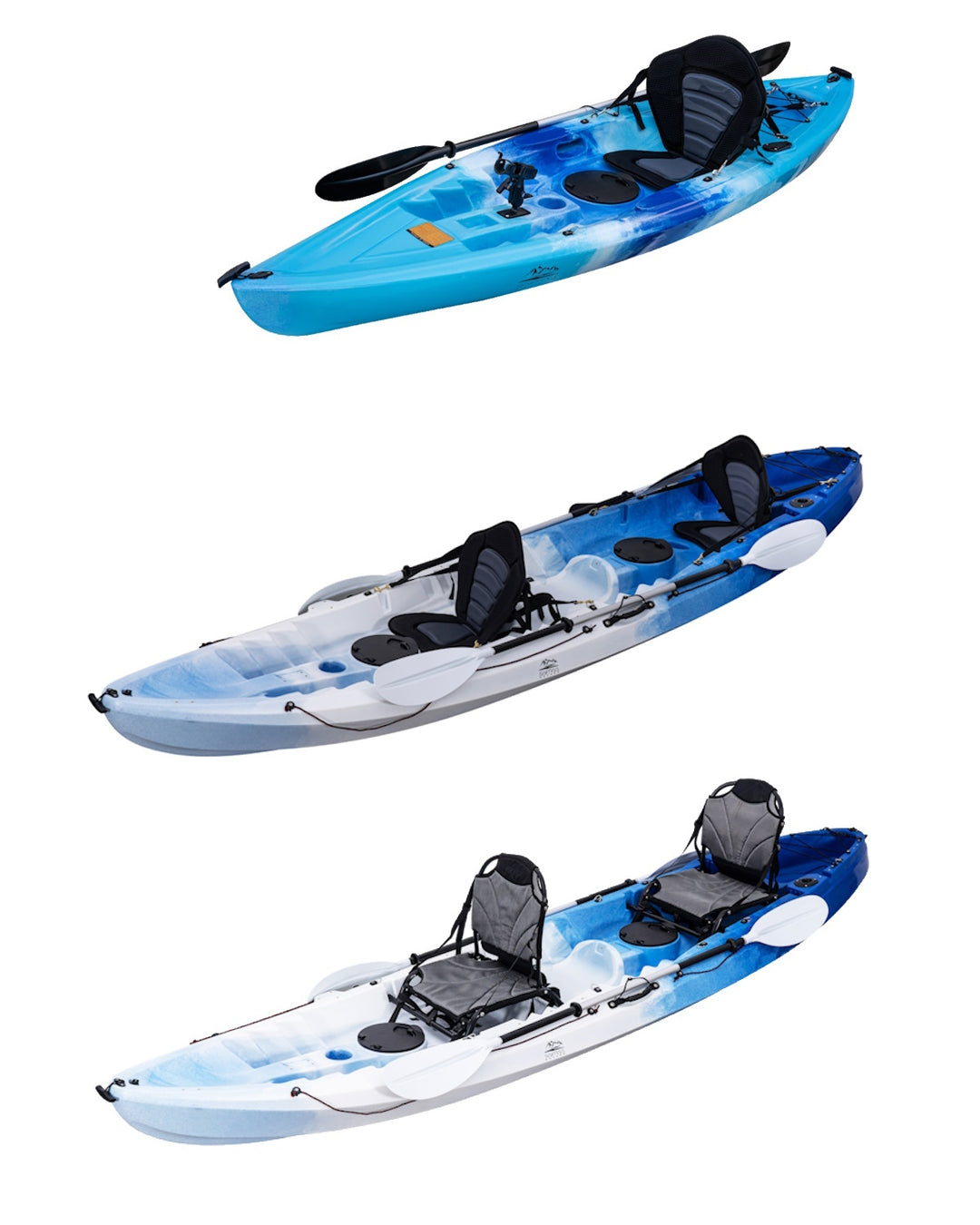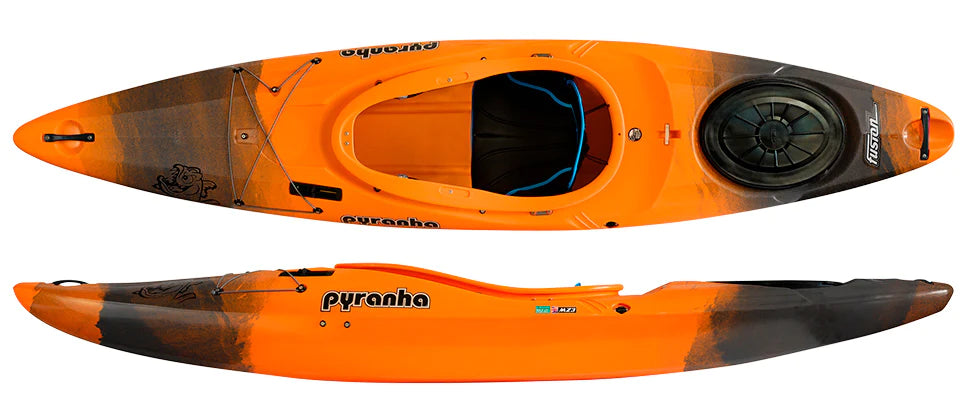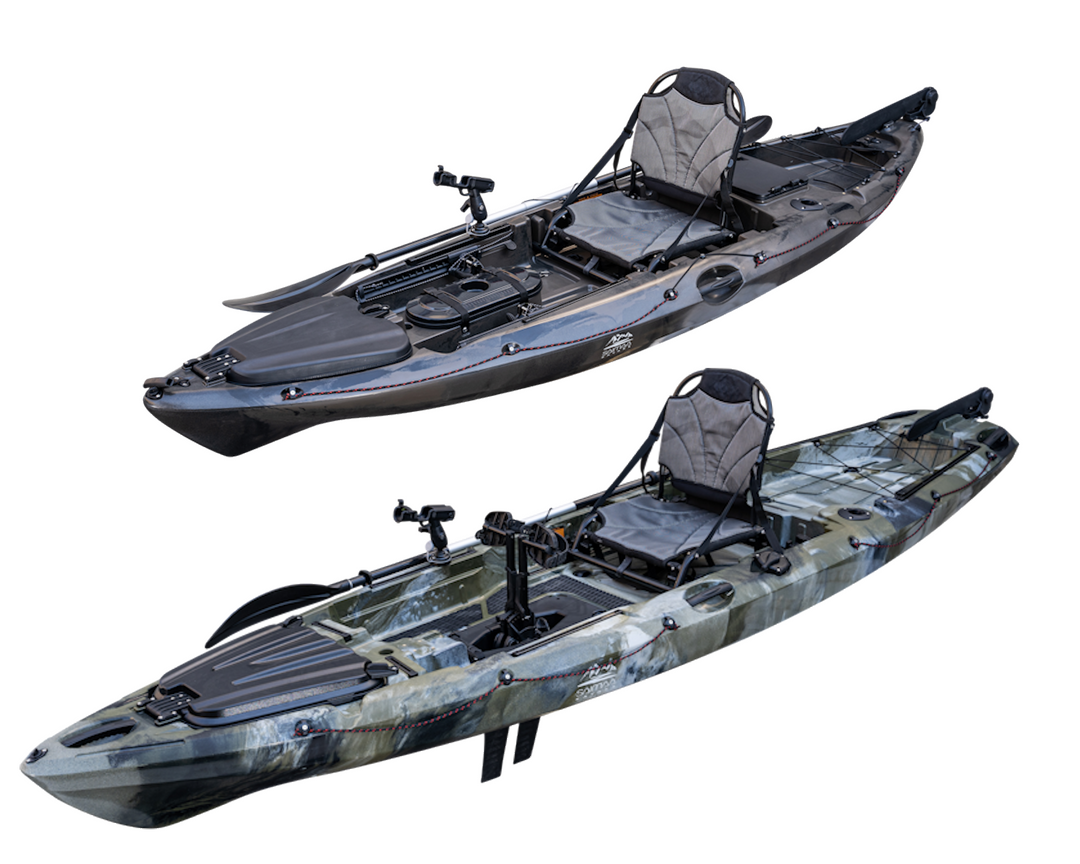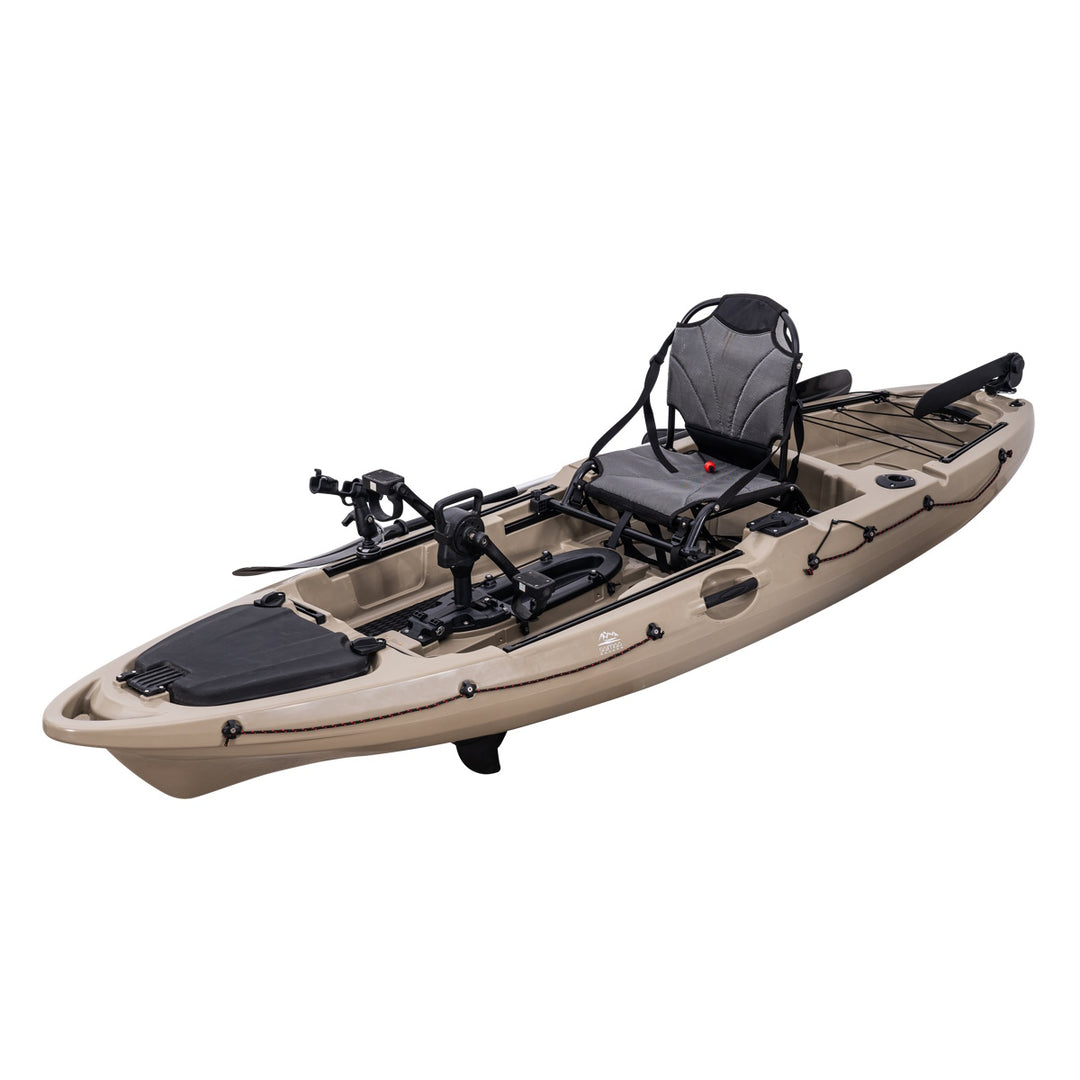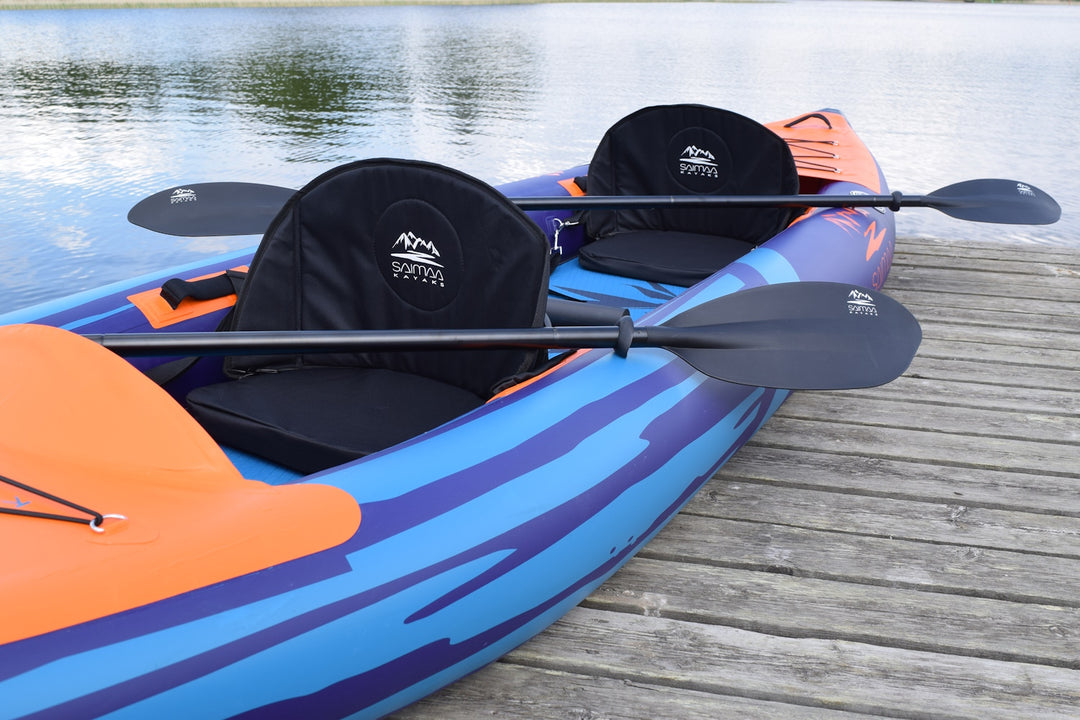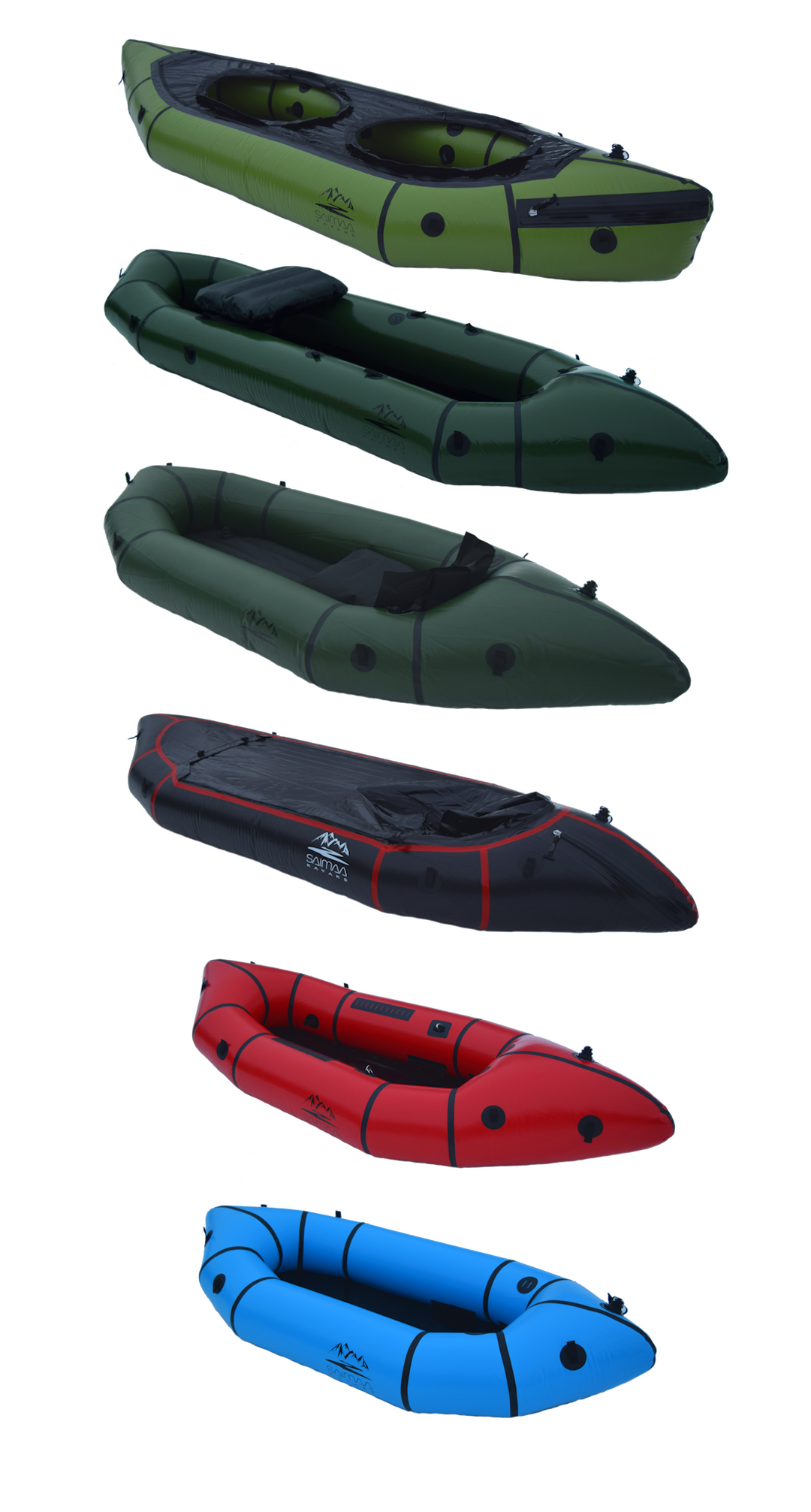Help for the selection
There is a huge range of equipment available for paddling and it can be difficult for a first-timer to find the right product for them. This guide starts with hard kayaks and canoes, then inflatable kayaks and finally packrafts to give you the most comprehensive overview of our range.
However, if you are not interested in industry terminology or technical details and you want just want to start with the right gear, or you're buying a product as a gift, contact our expert customer service team, and we will be happy to find the most suitable option for you.
Welcome to Mikkeli to test and explore our kayaks, so you can be sure to find the kayak that's right for you. (please arrange a test product of interest in advance with our customer service)!
Vesiurheilu.fi
Ratatie 10
50600 Mikkeli
Open weekdays 8-16
045 841 7744
Our team has been involved in water sports in its many forms for decades, and we price our products to match their characteristics. You won't find low-quality products or misleading promises - instead, you'll find professional product descriptions, advice and service on equipment selection, and quality rides in every price range.
We have been serving our customers from Mikkeli for +12 years all over Finland, and you will continue to find us on these pages for any paddling-related matter.
Hardshell kayaks
High-quality kayaks crafted from rigid, durable, and 100% recyclable polyethylene, designed for touring, sea kayaking, trekking, fishing, sports, and leisure. Our selection features premium models from P&H and Saimaa Kayaks.
Most kayaks come with extensive equipment packages and accessories, ensuring long-lasting performance and years of paddling enjoyment. We also offer river and whitewater kayaks, stable and beginner-friendly Sit-On-Top (SOT) kayaks, and classic Indian canoes for relaxed adventures on the water.
Inflatable kayaks
An inflatable kayak is the perfect choice when you don’t want to — or can’t — transport a traditional hardshell kayak on a car roof rack or trailer. Thanks to modern, high-quality designs, today’s inflatable kayaks offer a paddling experience nearly identical to hard kayaks, while packing neatly into the trunk of a standard sedan.
Our selection includes models from the pioneers of inflatable kayaking, Advanced Elements, as well as premium designs from Saimaa Kayaks.
Packrafts
Saimaa Kayaks ultra-light (2–4.5 kg) and compact packrafts are made from premium ripstop nylon, designed to be easily carried in a backpack, on a motorcycle, or even on a bicycle. The polyurethane-coated fabric ensures exceptional durability and years of reliable use in demanding conditions.
The range includes several models to suit different adventures: the Rapid for rivers, Fisher for angling, Feather for ultralight travel, Trek for all-around use, and Adventure for touring. Available in single and tandem versions depending on the model — click below to discover more!
Choose the right model for your purpose
By choosing the right gear from the start, you’ll enjoy your paddling hobby more, get better value for your investment, and build confidence right away. The right equipment means you can focus on learning and having fun instead of worrying about tipping over. As your skills improve, your kayak will continue to match your progress — so you won’t find yourself needing an upgrade after just one season.
Kayaking Frequently Asked Questions (FAQ)
A kayak is a long, narrow watercraft designed for paddling through various types of water. Over thousands of years, both the design and definition of kayaks have evolved. Traditionally, kayaks were closed, sit-in vessels developed by Arctic peoples for hunting and travel. Today, however, the term “kayak” covers a broader range of designs — including open and sit-on-top models — making the modern definition much more versatile and accessible to all kinds of paddlers.
For beginners, it’s best to start with a stable, wide, and flat-bottomed kayak. These models offer excellent initial stability, meaning the kayak feels steady and balanced even when you’re not moving.
In addition to the traditional sit-in kayak, sit-on-top models are a great choice for newcomers — they’re easy to get on and off, even for those with limited mobility, and provide a comfortable, confidence-building way to learn the basics of paddling.
Traditionally, the main difference between a kayak and a canoe was in their design: a kayak is an enclosed, sit-in vessel where the paddler sits inside the hull, while a canoe is open-topped, with the paddler seated higher up or kneeling.
Over time, the word canoe has also come to be used as a general term for small paddled boats, sometimes even referring to kayaks. For many, however, the term still evokes the image of a classic Indian canoe. Another key distinction lies in the paddle — a kayak paddle has two blades, one on each end, whereas a canoe paddle has a single blade.
Kayaks come in such a wide range of sizes, shapes, and designs that it’s impossible to make a blanket statement about their stability. Many river, touring, and sit-on-top kayaks are designed to be wide, stable, and easy to control, making them ideal for relaxed paddling and beginners.
By contrast, sea kayaks and especially racing kayaks are typically narrower and sleeker, built for speed, efficiency, and maneuverability — which can make them feel less stable at first, but far more responsive in skilled hands.
Tandem kayaks can also be paddled solo, as long as you balance the weight distribution properly — for instance, by placing your camping gear or extra load in the front. Thanks to their longer waterline, tandem kayaks often offer better directional stability than single kayaks, making them track straighter and glide more efficiently over longer distances.
Whether you’re a beginner or a strong swimmer, you should always wear a buoyancy aid when paddling. Right after that, neoprene accessories and waterproof clothing are the next most important safety essentials.
On warm summer days, you can get by with lighter gear, but in cold conditions or rough waters, a drysuit is highly recommended to keep you safe and comfortable no matter what happens. Always pack spare clothes in a waterproof bag, and don’t forget to protect yourself from the sun with sunscreen, a hat, or UV-protective clothing.
A two-bladed kayak paddle is used with a light grip, slightly wider than shoulder width. Each stroke begins with the blade entering the water near your feet, then pulling it smoothly alongside the kayak until it reaches your hip, where you lift it out. Alternate sides rhythmically, and you’ll soon start to feel the natural flow of the paddle.
Remember, paddling isn’t about arm strength — it’s about engaging your whole body. Your footrests provide support: when pulling on the right side, press your right foot against the rest while rotating your torso and shoulders to power the stroke.
Good technique comes only with practice and repetition, so there’s no need to stress about it early on. However, for longer trips, proper form is essential to avoid fatigue. With good technique and steady pacing, you can comfortably paddle all day.
A canoe paddle is typically a single-bladed, traditional paddle used on one side of the canoe at a time. To paddle efficiently, place the blade in the water near the front tip of the canoe and pull it straight back in line with the hull. For the best control and balance, end the stroke when the blade reaches your hip or the side of your body, then lift it out smoothly before repeating.
A packraft is an inflatable, ultra-lightweight (2–5.5 kg), multi-purpose watercraft designed for adventure and portability. Despite its compact size, a packraft is surprisingly durable and stable, easily packing down to fit into a backpack or bike bag.
Because of this versatility, packrafts have become extremely popular among hikers, trekkers, and bikepackers who want to combine land and water travel in one journey. They’re ideal for exploring remote lakes, rivers, and wilderness routes, and their rugged construction ensures reliable performance even in challenging conditions.
Kayak Buyer’s Guide: Why Choose a Hardshell Kayak?
Hardshell kayaks remain by far the most popular type of kayak in Finland, although inflatable models have gained attention in recent years. Hard kayaks are available for many different uses and environments — from river and whitewater kayaks to touring kayaks, sea kayaks, sit-on-top (SOT) models, and fishing kayaks. But how do you choose the right one for your needs?
Start by considering where and how you’ll use the kayak. Will you be paddling mainly on the sea, lakes, or rivers? Are you planning longer expeditions, or just short day trips — perhaps from your cottage or campsite? Do you want a more athletic workout, or are you looking for a relaxed nature experience?
Paddling is excellent for shoulder strength, upper-body muscles, and mobility, which are often limited by sedentary work. However, choosing a kayak that’s too advanced or unstable can make paddling stressful instead of relaxing. If you’re constantly tense for fear of tipping, you won’t get the full joint-loosening and stress-relieving benefits of the sport. Still, practice makes perfect — and even beginners who enjoy a challenge can confidently choose a faster, sportier model as their first kayak.
Size
When buying a kayak, consider the shape and size of the hull. A kayak that’s too large will float high on the water, making it harder to control in wind. One that’s too small may feel cramped, limit movement, and make it difficult to find a comfortable paddling position. It’s also harder to enter and exit if the cockpit opening is too tight. Kayak size is often marked as LV (Low Volume), MV (Medium Volume), and HV (High Volume) — with LV being the smallest, MV the mid-range, and HV the largest.
Length
For longer paddling trips, choose a kayak with ample storage space for camping gear such as a tent, sleeping bag, food, and clothing. Length also affects performance — as a rule of thumb, longer kayaks glide better and move more efficiently than shorter ones. They also tend to have more cargo capacity, making them ideal for touring and multi-day adventures.
Width
The width of a kayak has a direct impact on its stability. Generally, a wider kayak feels more stable and forgiving, which makes it easier for beginners. However, width alone doesn’t determine stability — the shape of the hull also plays a key role.
Hull Shape
The hull shape (bottom contour) significantly influences how stable or lively a kayak feels on the water. Hulls can be flat, rounded, V-shaped, or a blend of these forms. A flat-bottom hull provides excellent initial stability, making it a great choice for beginners who want to relax and enjoy the scenery. A gently V-shaped hull offers a balance of stability and maneuverability, which has made it increasingly popular among recreational paddlers. A deep V-shaped or round-bottom hull, on the other hand, can feel challenging for beginners but offers speed, directional stability, and smooth handling in waves for experienced paddlers. Also keep in mind that wave conditions differ between lakes and the sea, so the ideal hull shape depends on your main paddling environment.
Equipment and Comfort
If you’re buying a flat-bottomed or touring kayak for longer distances, make sure it includes a rudder or skeg (directional fin). These features help the kayak track straight, even in crosswinds, reducing the need to constantly correct your direction. A rudder or skeg is standard on most well-equipped touring models. Pay close attention to the seat quality, too. Try sitting in a few kayaks — you’ll immediately feel the difference. A poor seat can cause discomfort or numbness, quickly taking the fun out of paddling. Finally, check that the storage compartments meet your needs and that they’re equipped with watertight hatches to keep your gear dry.
river kayaks
A shorter kayak, typically around 3–4 metres, is ideal for river paddling. On smaller rivers and rapids, a shorter kayak offers better agility and easier maneuvering, allowing you to turn quickly and react to changing conditions. Shorter models are also lighter to carry, which makes portaging around rapids or obstacles much easier.
For larger or calmer rivers, you may prefer a slightly longer kayak that provides more speed and smoother tracking, especially if you’re not planning to tackle rough rapids.
Excellent examples of versatile river kayaks include the Saimaa Kayaks Smart and the P&H Virgo MV, both offering great balance between stability, responsiveness, and performance.
Touring Kayaks
Touring kayaks, typically 4–5 metres long, are excellent for comfortable trekking and recreational adventures. This length range is especially popular on Finnish lakes and coastal waters, offering a great balance between speed, stability, and storage space.
Many touring kayaks handle well in sheltered sea areas and larger lakes, making them versatile choices for a wide range of conditions. Their size is ideal for both day trips and multi-day excursions, providing enough space for gear without sacrificing maneuverability.
Great examples of reliable touring kayaks include the Saimaa Kayaks Trek and the P&H Virgo, both known for their smooth glide, comfort, and well-thought-out design for extended paddling.
Sea kayaks
Sea kayaks are designed for touring in open water and typically range from around 5 to 6 metres in length. Their longer, streamlined hulls provide excellent glide, directional stability, and efficiency, making them ideal for coastal adventures and longer expeditions.
Our sea kayak selection features premium models from P&H, including the popular Virgo, Leo, and Scorpio, all known for their exceptional build quality, comfort, and performance in demanding sea conditions.
P&H Kayaks
The British company P&H Kayaks has been setting the standard for premium kayak design and craftsmanship for over 50 years. If you’re looking for a kayak that combines advanced design, outstanding performance on both lakes and at sea, and exceptional material quality, P&H is the perfect choice.
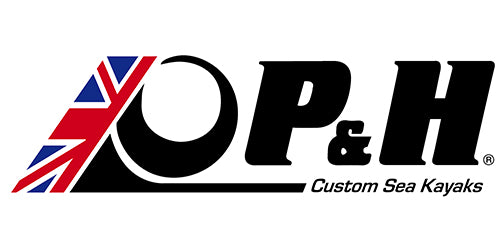
Open kayaks (Sit-on-Top / SOT)
In recent years, open-top kayaks (SOT – Sit-on-Top) have become increasingly popular in Finland. These models have long been favorites in warmer countries and beach destinations thanks to their ease of use and accessibility.
A Sit-on-Top kayak is simple to get on and off, making it especially beginner-friendly. However, because SOT kayaks cannot be fitted with a spray deck, you’ll need warmer or waterproof clothing in cold or rainy weather.
SOT kayaks are a safe and stable alternative for anyone who feels uneasy about entering a traditional sit-in kayak. Their open and steady design also makes them ideal for children and family use.
Indian canoe Puno
The easy-to-paddle Puno Indian canoe brings river and lake adventures right to your cottage shore! Its low-profile design minimizes wind resistance, making it stable and efficient even in breezy conditions. Thanks to its small wind area, the Puno canoe performs beautifully on both lakes and coastal waters, without the side-drift issues common in higher-sided traditional canoes.
Whitewater kayaks
Kayaks are available for both camping trips and freestyle paddling in rapids. These models are typically shorter and more agile than traditional river kayaks, allowing for quick turns and precise control in moving water. A great example is the Pyranha Fusion M Stout, which combines responsiveness and stability for both play and adventure paddling.
Fishing kayaks
When choosing a fishing kayak, focus on stability, storage capacity, and mounting options — such as rod and net holders and attachment rails, which let you easily customize your own setup. Comfort is equally important: a well-designed seat ensures you can stay out all day without fatigue, even if the fish aren’t biting.
Our fishing kayak range includes both the paddle-powered Fisher and the foot-pedal-driven Pedal Fisher models. The pedal versions offer the big advantage of hands-free operation, making them perfect for trolling and active fishing.
Pedal kayak
The Pedal Kayak Pedal Propeller is like riding a bike on water — a stable and versatile kayak that glides effortlessly across the surface using either pedal power or a paddle. Its 360° rotating pedal drive lets you cruise smoothly or get a solid workout whenever you want.
The pedal unit can be easily lifted out mid-trip, allowing you to switch seamlessly to paddling with your hands and engage your whole body for a more balanced and active experience on the water.
The fishing kayaks and pedal kayaks mentioned above all feature four accessory mounting rails, a paddle holder, rod stands, and a durable, high-quality polyethylene hull built to last.Each model also includes a dedicated sonar sensor mount at the front of the kayak. This allows you to easily position the probe beneath the hull, while the sonar display can be conveniently mounted to the rail system using an optional sonar mount — keeping your setup organized, efficient, and ready for action on the water.
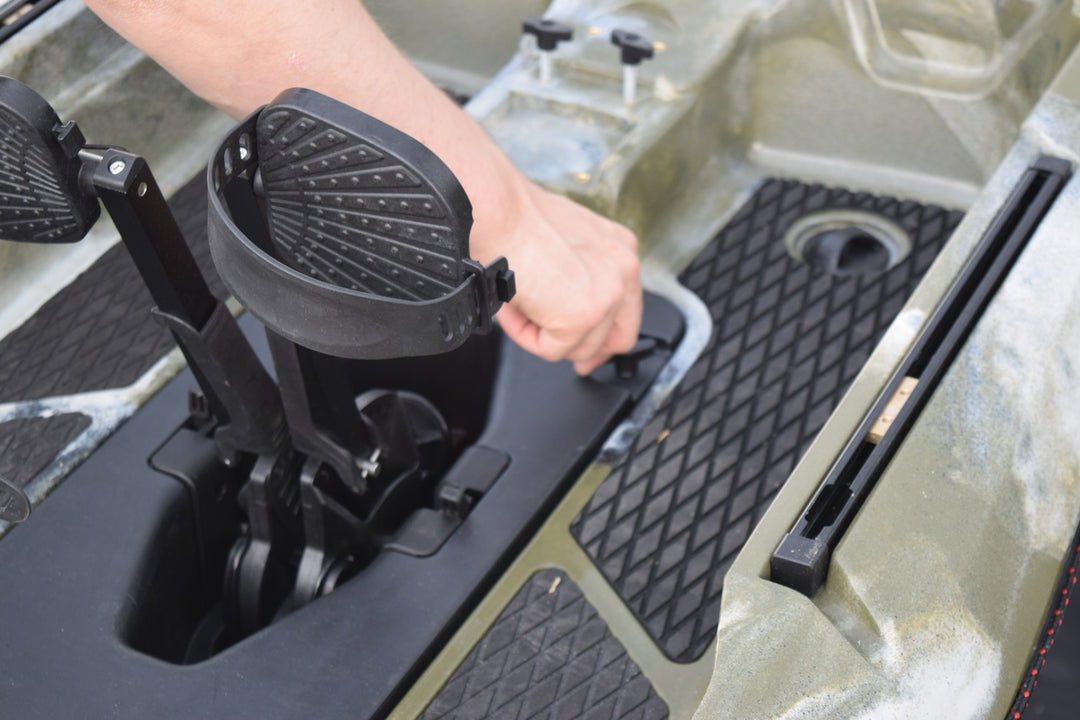
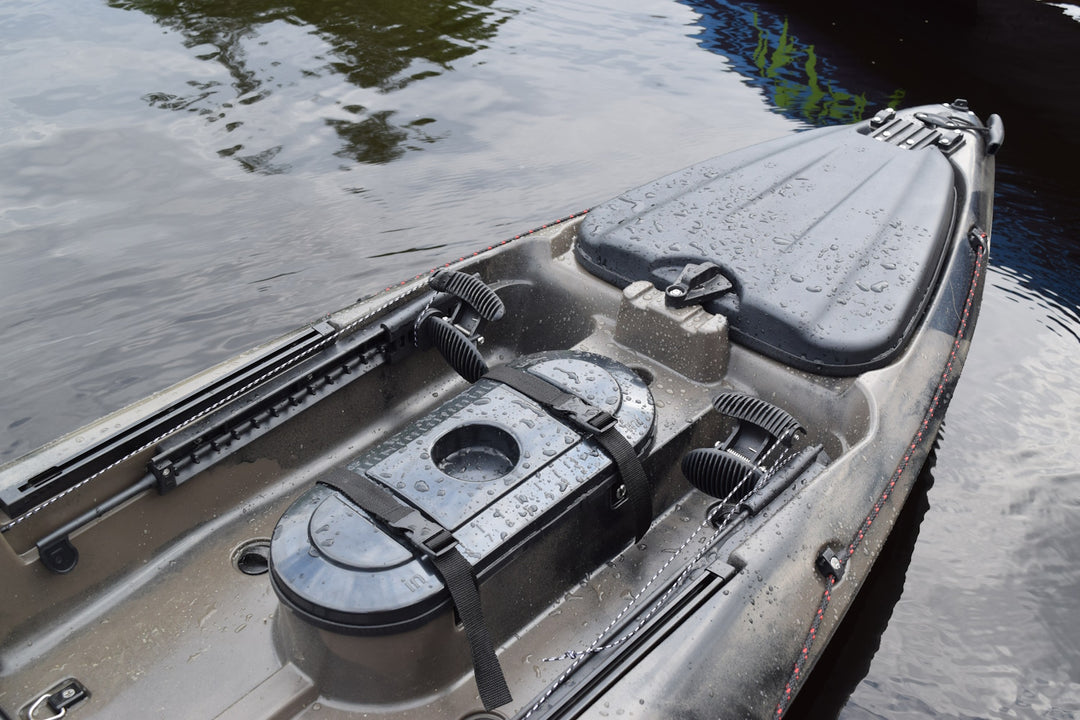
Saimaa Kayaks
The Saimaa Kayaks range includes inflatable and hardshell kayaks and canoes, as well as ultralight packrafts. The same exceptional price-to-performance ratio known from Saimaa SUP is now available across multiple categories — each featuring well-designed equipment packages and backed by a satisfaction guarantee.
Whether you’re looking for a durable hardshell kayak for fishing, a lightweight packraft for trekking, or an inflatable canoe for your rental business, Saimaa Kayaks delivers it all — with fast shipping, expert support, and quality you can rely on.

Inflatable Kayak Buyer’s Guide
The inflatable kayak is a compact and versatile choice for outdoor enthusiasts. It’s easy to transport, fits neatly into the trunk of a car, and can be set up in just minutes, making it perfect for spontaneous paddling trips.
When choosing an inflatable kayak, one key factor is the construction method — whether it uses round pontoon-style tubes or narrower, upright drop-stitch sides.
- Round pontoon hulls offer excellent stability and are less affected by crosswinds.
- Drop-stitch hulls, on the other hand, are narrower, faster, and better at cutting through waves, though they can feel slightly more sensitive to balance.
The Saimaa Kayaks Adventure is a wide, open inflatable kayak that combines round pontoons with a rigid drop-stitch floor for outstanding stability. Thanks to its generous width, it’s easy to handle, even for beginners or paddlers with limited balance. The drop-stitch floor, similar to those used in SUP boards, provides a solid, supportive base that maintains the kayak’s shape even under heavier paddlers.
Most inflatable kayaks are sold as complete packages, including a pump and paddle. However, while the included paddle is usually functional for beginners, many paddlers eventually upgrade to a higher-quality paddle suited to their own height and style — keeping the original one as a spare or backup.
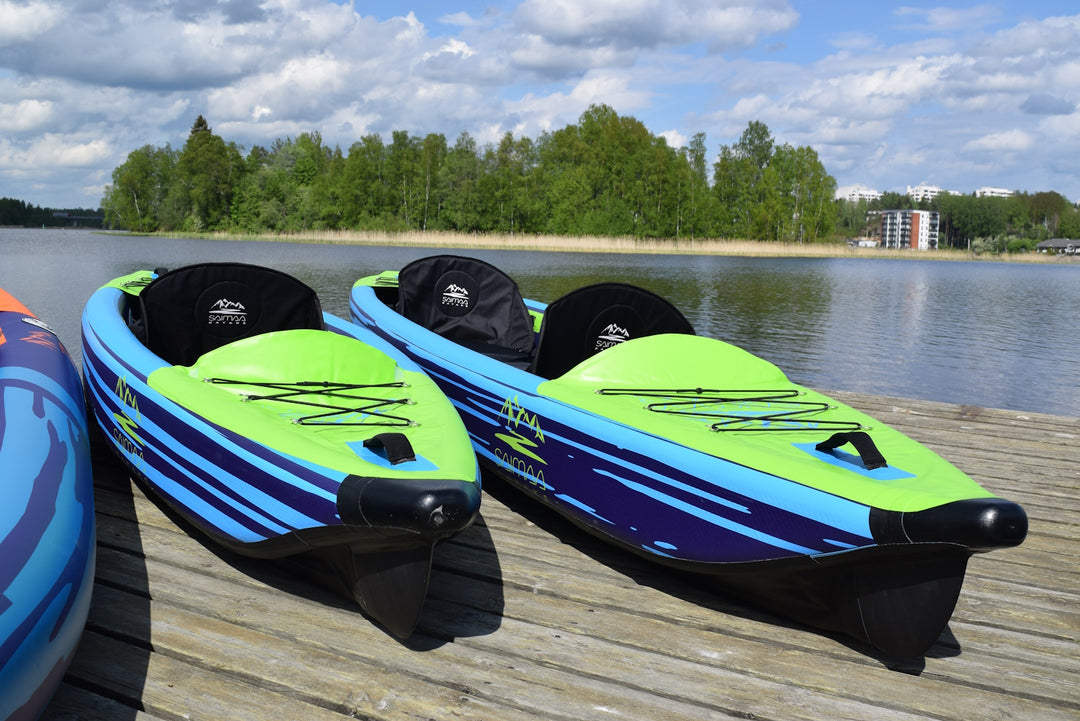
The Expedition is a high-performance inflatable kayak built entirely with drop-stitch construction, giving it a narrower profile, greater speed, and an impressively rigid structure. Its V-shaped hard plastic bow and stern inserts enhance directional stability and allow the kayak to cut through waves smoothly, even in challenging conditions.
Thanks to the stiffness and precision of its drop-stitch design, the Expedition offers a solid, hardshell-like feel, making it exceptionally comfortable and responsive — even for experienced paddlers. Despite its performance-focused build, it remains compact when deflated, fitting easily into the trunk or back seat of most cars.
The Expedition truly combines the best qualities of hardshell and inflatable kayaks into one durable, versatile package — perfect for paddlers who demand both speed and portability.
Packraft Buyer’s Guide
One or Two Paddlers?
The first big decision when choosing a packraft is the number of users. If you usually paddle alone, a single-person packraft is the right choice. However, if you plan to paddle with a partner — even occasionally — a tandem model offers more flexibility.
One of the main advantages of two-person packrafts is their versatility. In open-deck (deckless) models, you can easily adjust the seat position when paddling solo and use the extra space for gear storage or even your dog.
If your model has a spraydeck, solo paddling may position you slightly toward the rear, but you can easily balance the center of gravity by placing your gear in the bow.
Features and Intended Use
There are significant functional differences between packraft models, depending on how and where you use them.
If your packraft is primarily for hiking or expedition use — for example, to cross rivers or lakes on a long trek — the weight and packed size become very important. In this case, consider an ultralight model such as the Saimaa Kayaks Feather, which offers excellent portability without compromising strength.
If your main use is fishing or exploring remote waterways with a friend, opt for a tandem model built from stronger, more durable materials, such as the Saimaa Kayaks Fisher Twin, which offers extra stability and carrying capacity.
For those looking for a versatile, all-round packraft suitable for both calm and gently flowing water, the Saimaa Kayaks Packraft Trek is a proven favorite. It features a long and wide hull, excellent load capacity, and still weighs only 2.5 kg, making it easy to carry anywhere.
If you want a step above the standard, the Saimaa Kayaks Adventure and Adventure Twin are premium, fully equipped packrafts featuring a spraydeck cover and internal pontoon storage system. Made from strong, reinforced materials, they remain light and portable — even the Adventure Twin, at 4.1 kg, is easy to carry on longer trips.
For whitewater use, a spraydeck cover and/or self-bailing floor are essential. A self-bailing floor has drain holes along the sides, allowing water to escape automatically — crucial when paddling in rapids where splashes are frequent. A good example is the Saimaa Kayaks Packraft Rapid, which features this system for effortless drainage and control.
Space and Load Capacity
Your height and weight also influence the right packraft choice. A 165 cm paddler with light gear may fit comfortably even in a compact model, whereas a 195 cm paddler could find the same boat too cramped.
All our product pages include internal and external dimensions as well as maximum load capacity. It’s a good idea to estimate your combined weight (you + your gear) to ensure the packraft can carry everything comfortably.
Especially on longer expeditions, comfort and space are key to enjoyment. Make sure you can sit and move comfortably in your packraft — a good fit means better paddling performance and a much more enjoyable trip.
Deck covers and spraydecks play an important role in both comfort and protection. A full deck cover (or coverlet) shields the entire deck area, while a gap cover (slip-on skirt) closes only the cockpit opening — similar to a traditional hardshell kayak.
A deck cover keeps splashes, rain, and wind out of the kayak, ensuring your lower body and gear stay dry. Depending on the model, the cover can often be removed or rolled open, allowing you to enjoy the sunshine once the weather clears.
For longer expeditions, a zippered internal storage system inside the pontoon tubes is a fantastic feature. When the packraft is deflated, you can place your drybags inside the pontoons, inflate the raft, and your gear will be securely stored inside the hull. Note that this system is best used for items you don’t need while paddling — keep your essentials in a bow bag or on the floor of the raft for easy access.
Essential Packrafting Gear
At a minimum, you'll need:
- A packraft
- A paddle (included in Saimaa packrafts)
- Repair tools (included in Saimaa packrafts)
- A buoyancy aid, life jacket or life vest
(We have a separate guide dedicated to choosing the right buoyancy aid.)
To make your adventures more comfortable and organized, consider adding drybags, waterproof phone pouches, belt packs, and other small accessories to protect and organize your essentials. Using drybags also helps you make better use of internal space while keeping everything dry and secure.
Packraft Materials
High-quality packrafts are typically made from cross-woven ripstop nylon coated with a durable polyurethane (TPU) layer. This combination offers exceptional tensile and tear strength — so even though the fabric is thin and lightweight, it’s remarkably tough and resistant to damage.
The TPU coating gives the surface a smooth, abrasion-resistant, and UV-protected finish, ensuring your packraft will last for many seasons of use.
Even with robust materials, sharp rocks or heavy impacts can cause punctures. Fortunately, packrafts are easy to repair — minor fixes can often be done in minutes with a small repair kit, allowing you to continue your trip without interruption.
For longer adventures, always bring a basic repair kit that includes cleaning wipes, material patches, glue, and tape (such as Tyvek or Stormsure Tuff Tape) to handle any unexpected damage.
